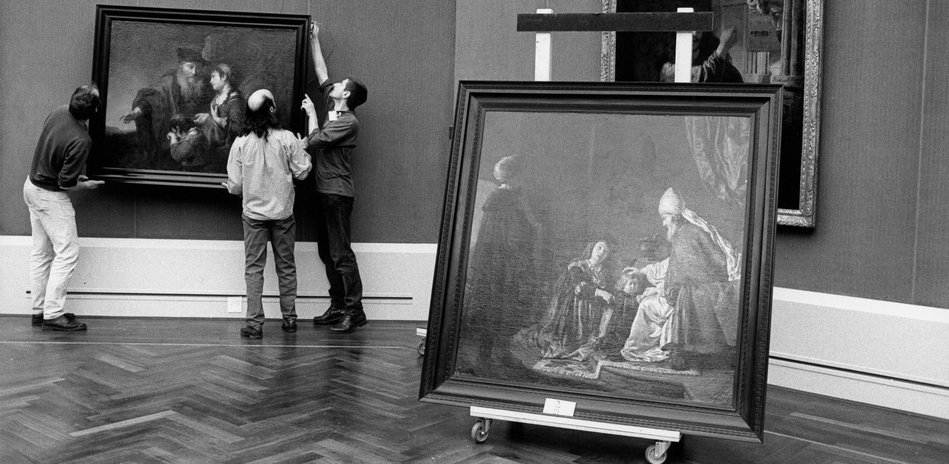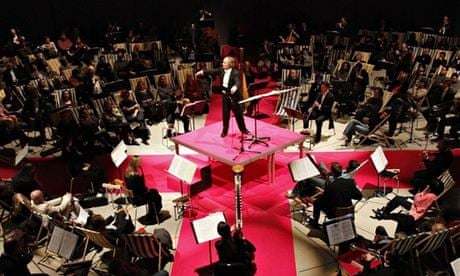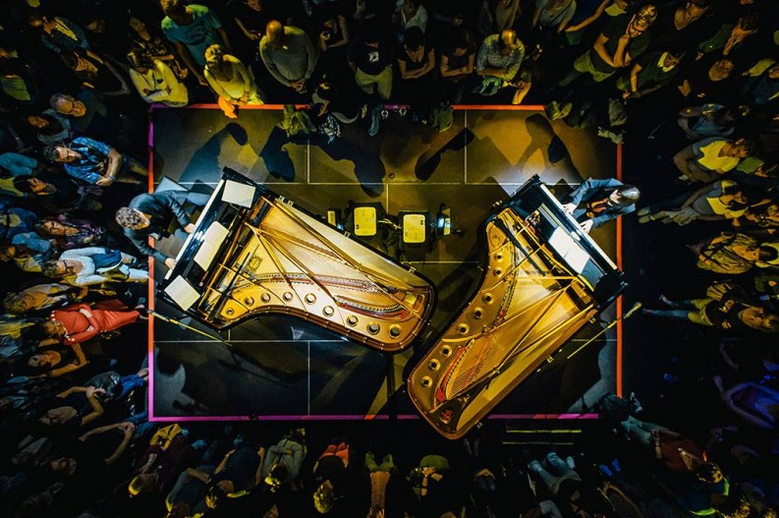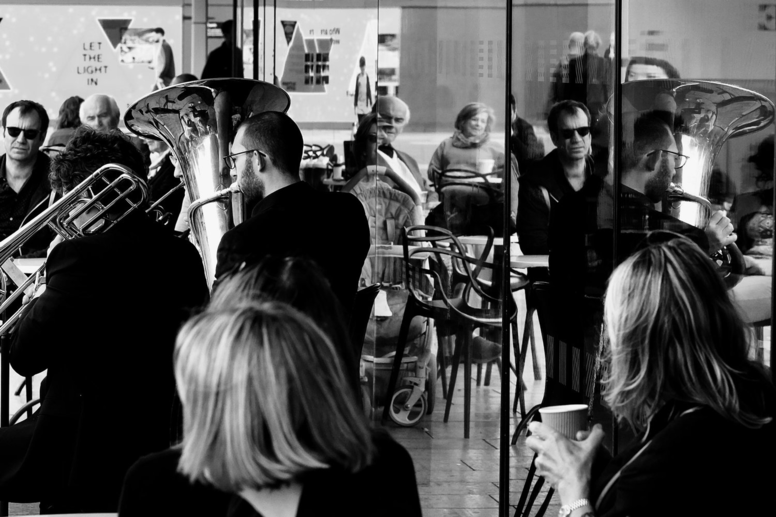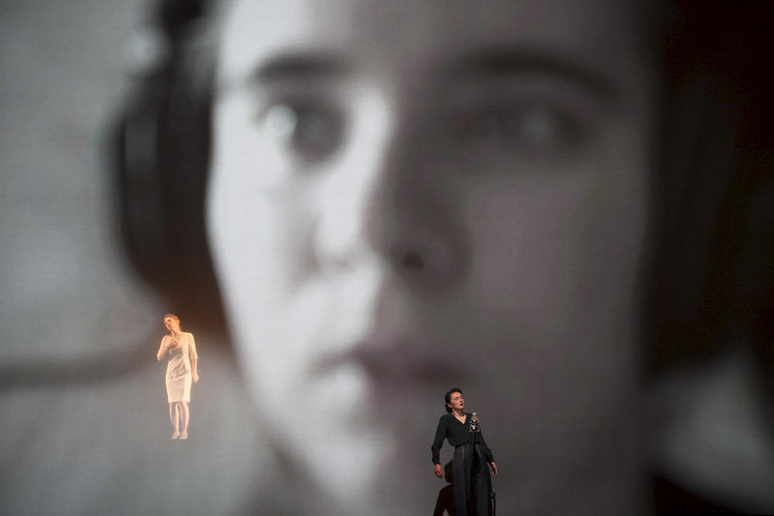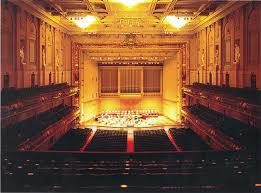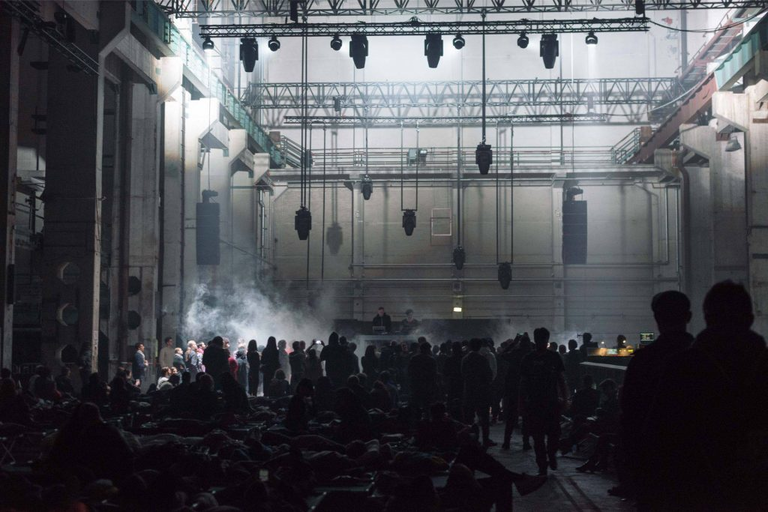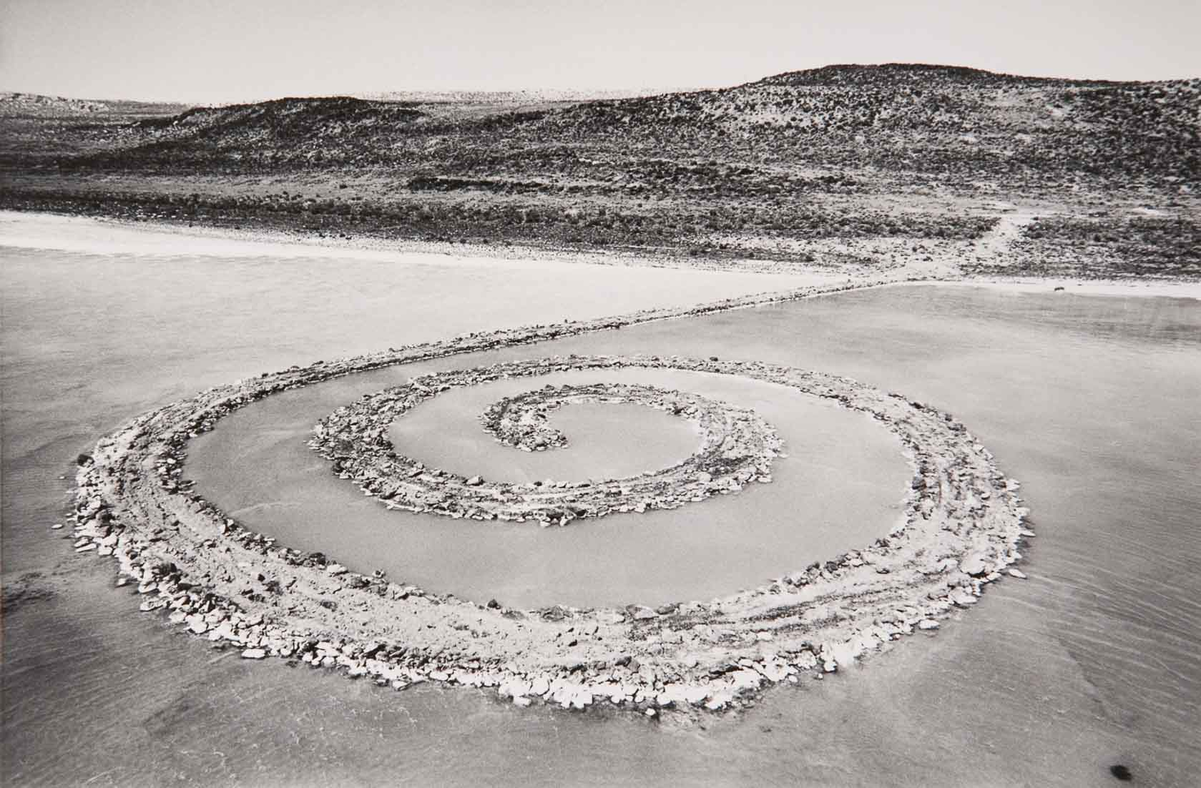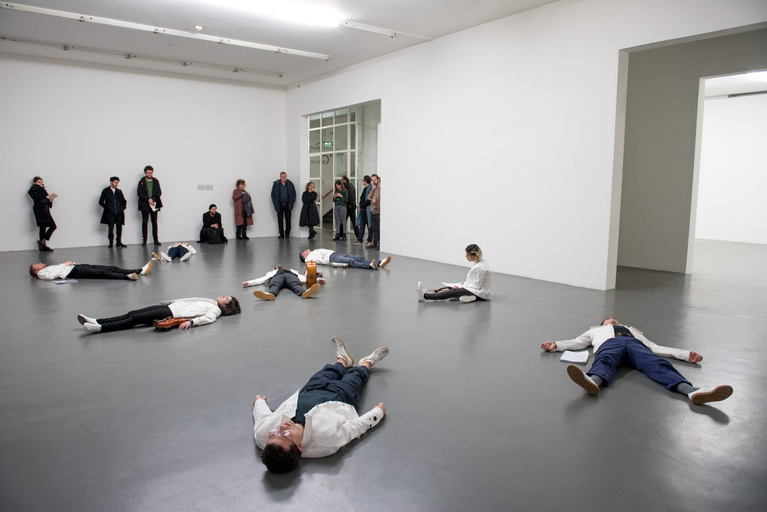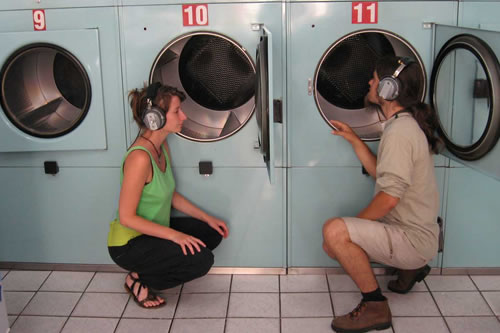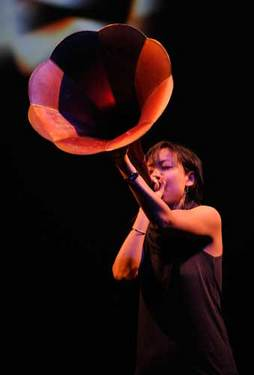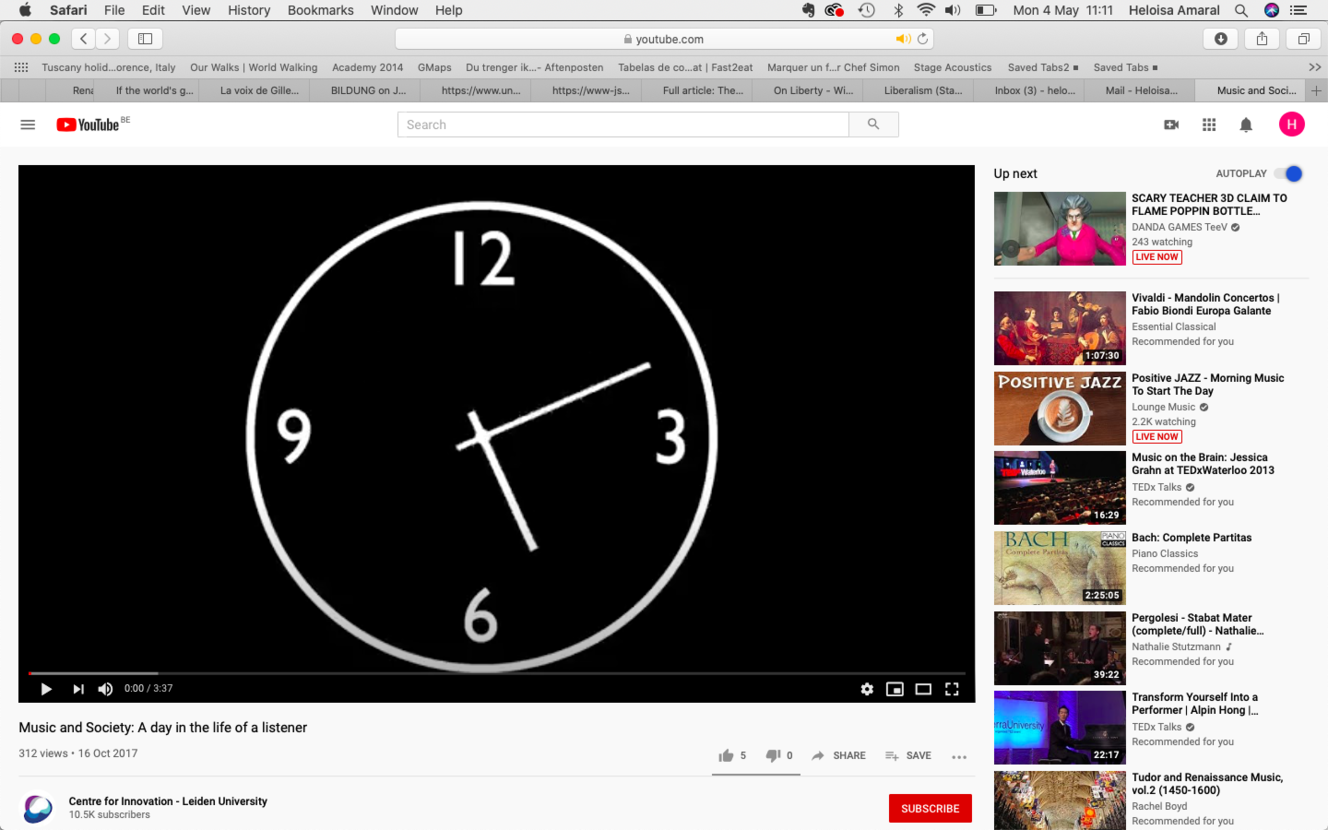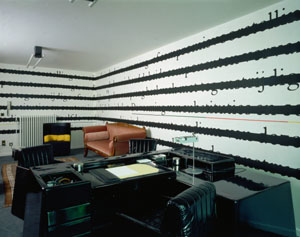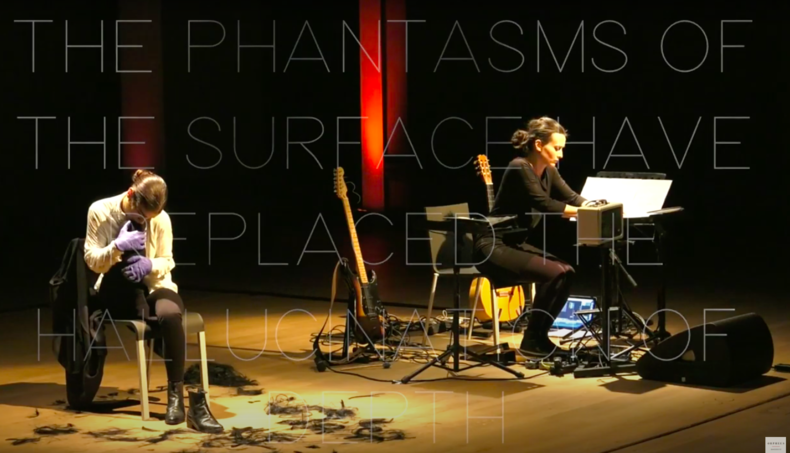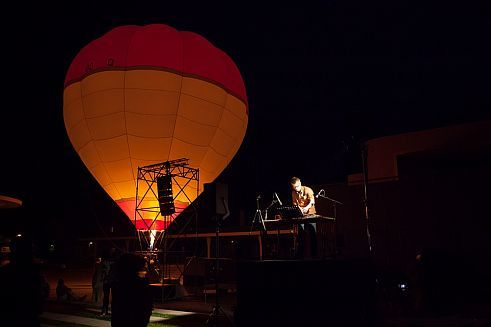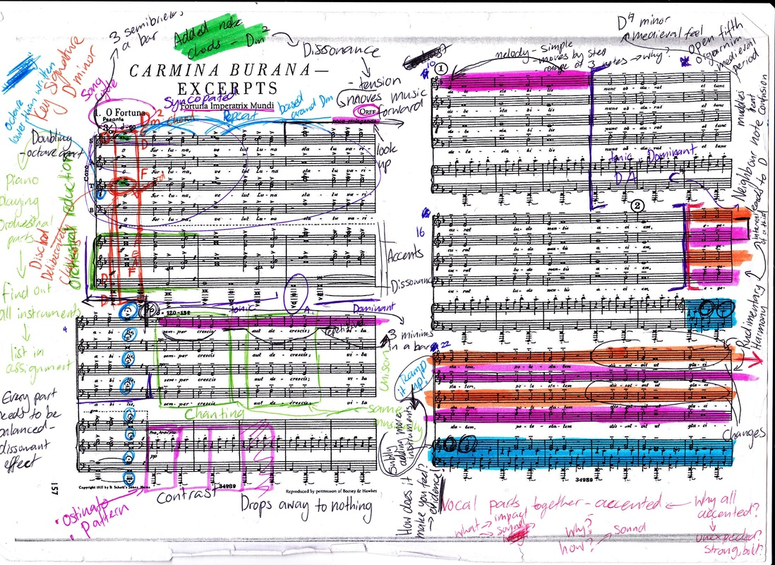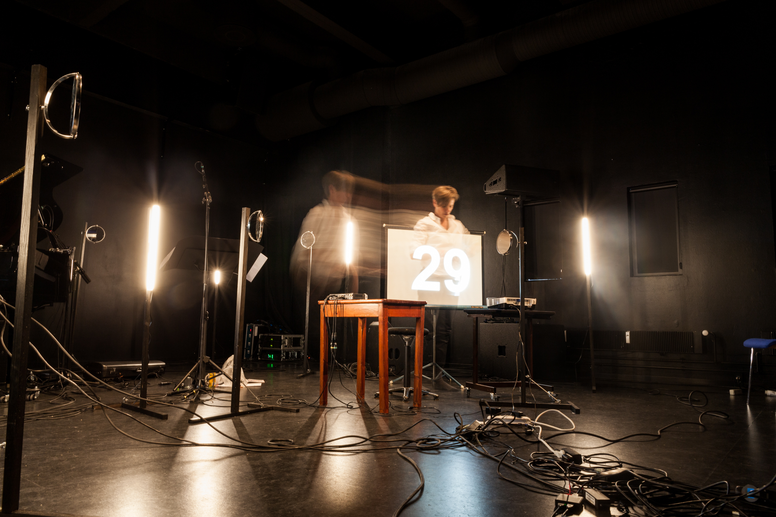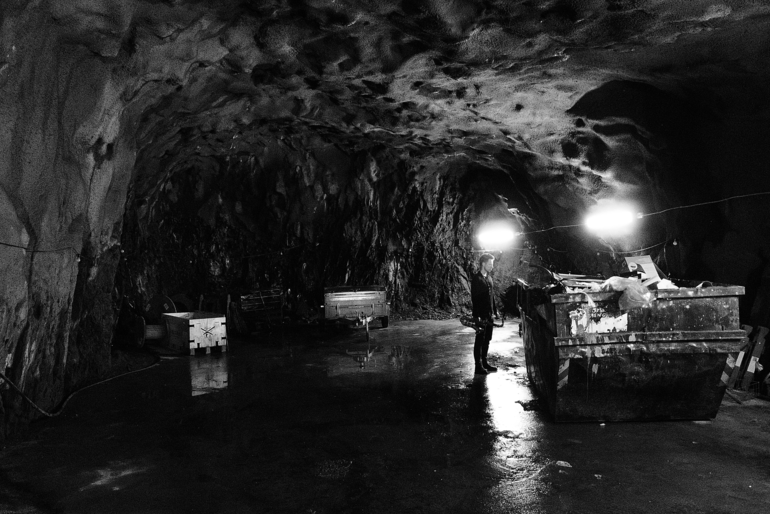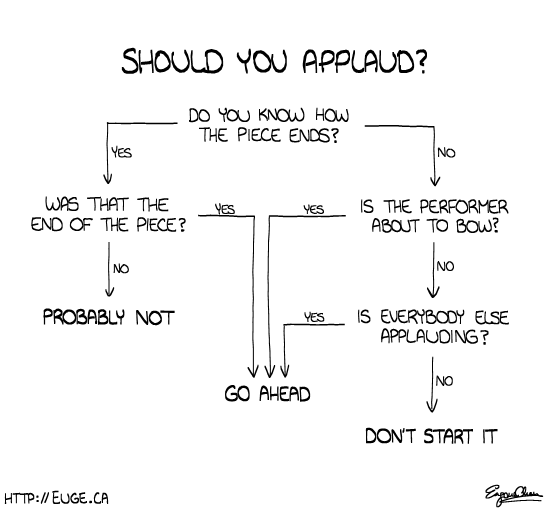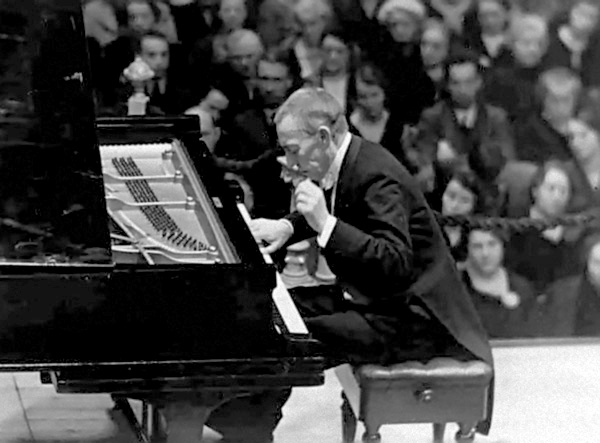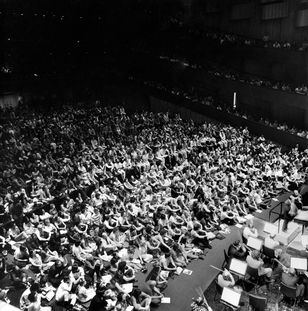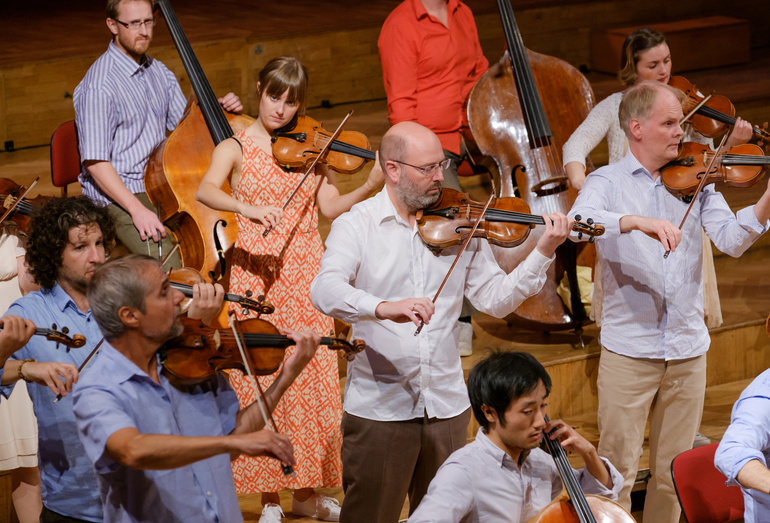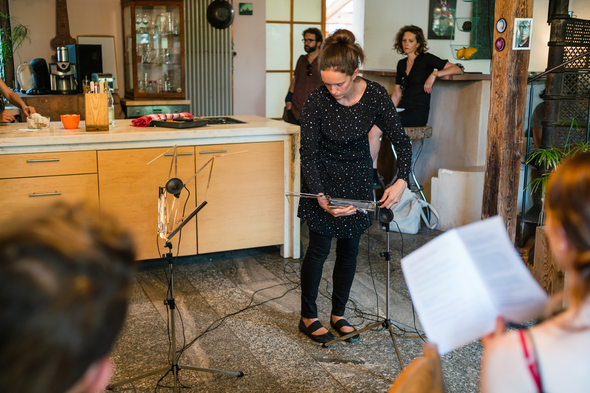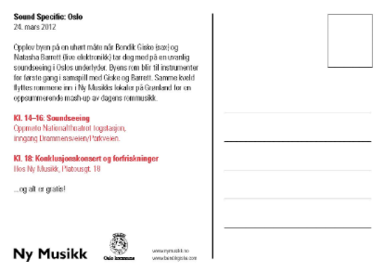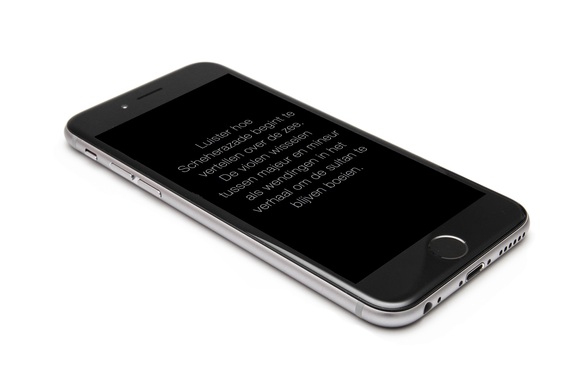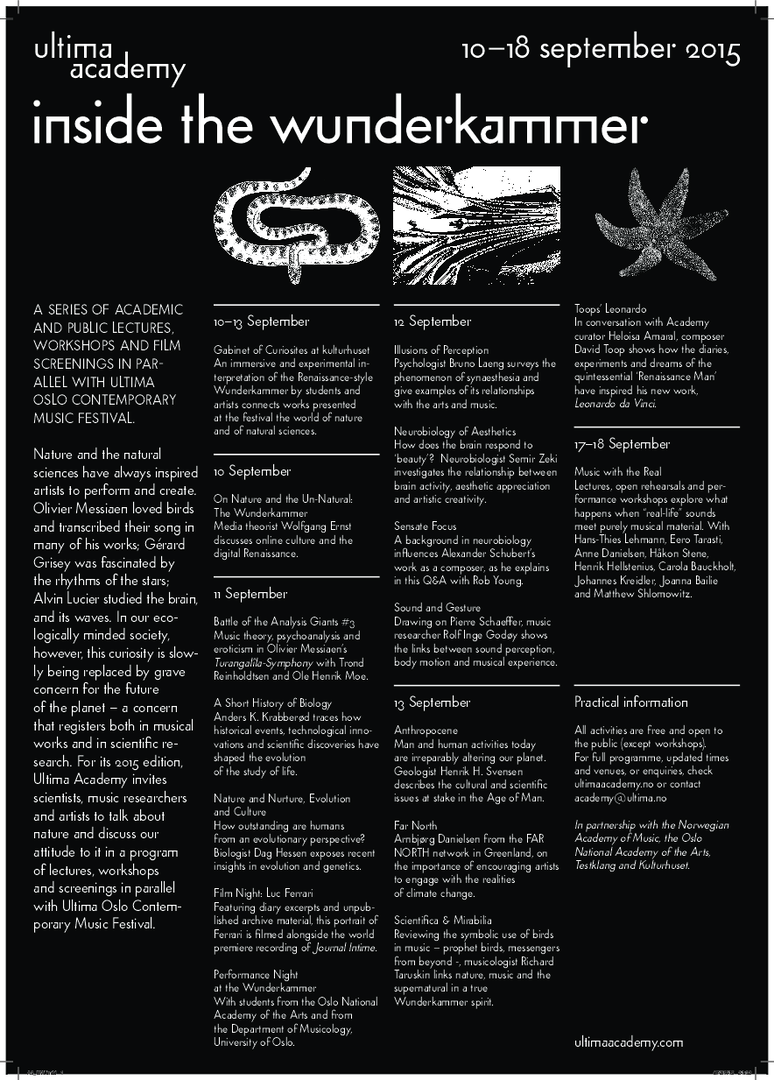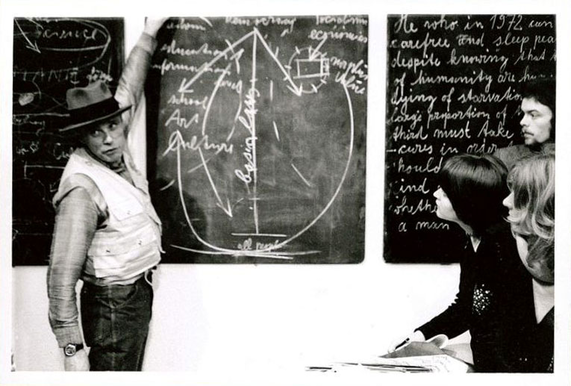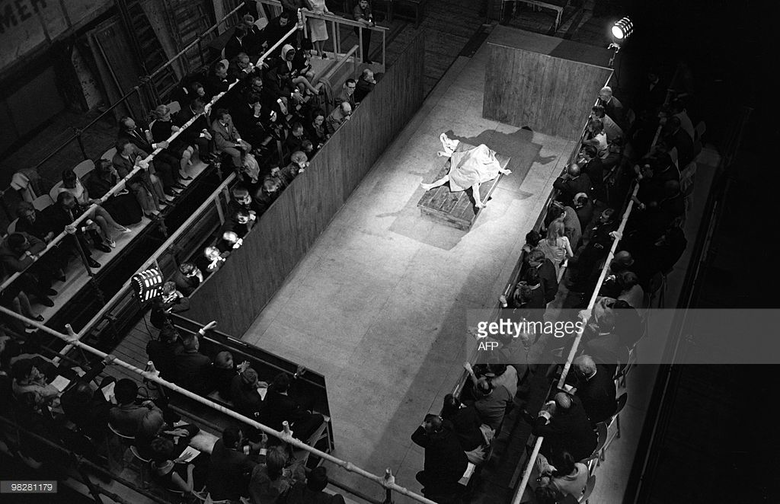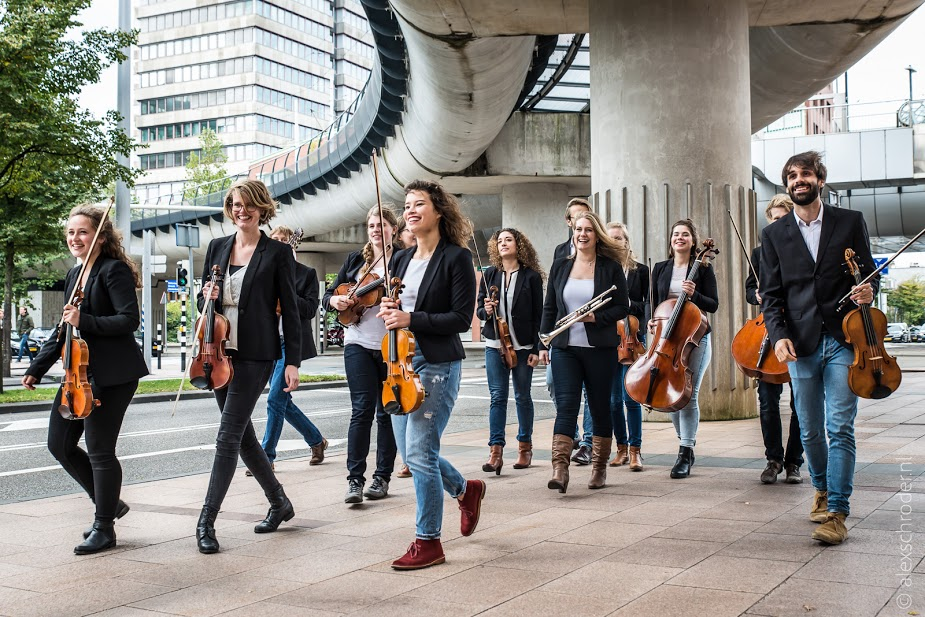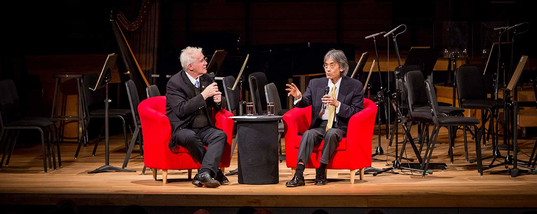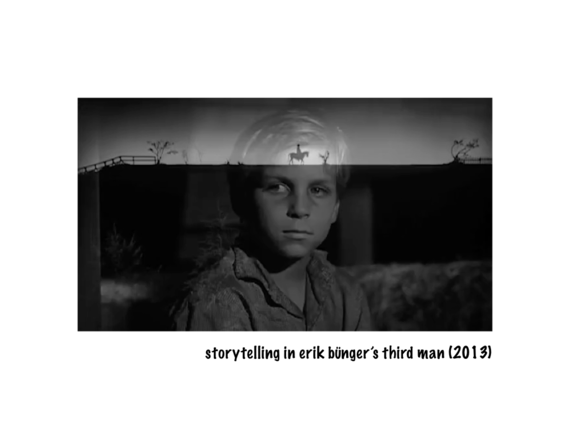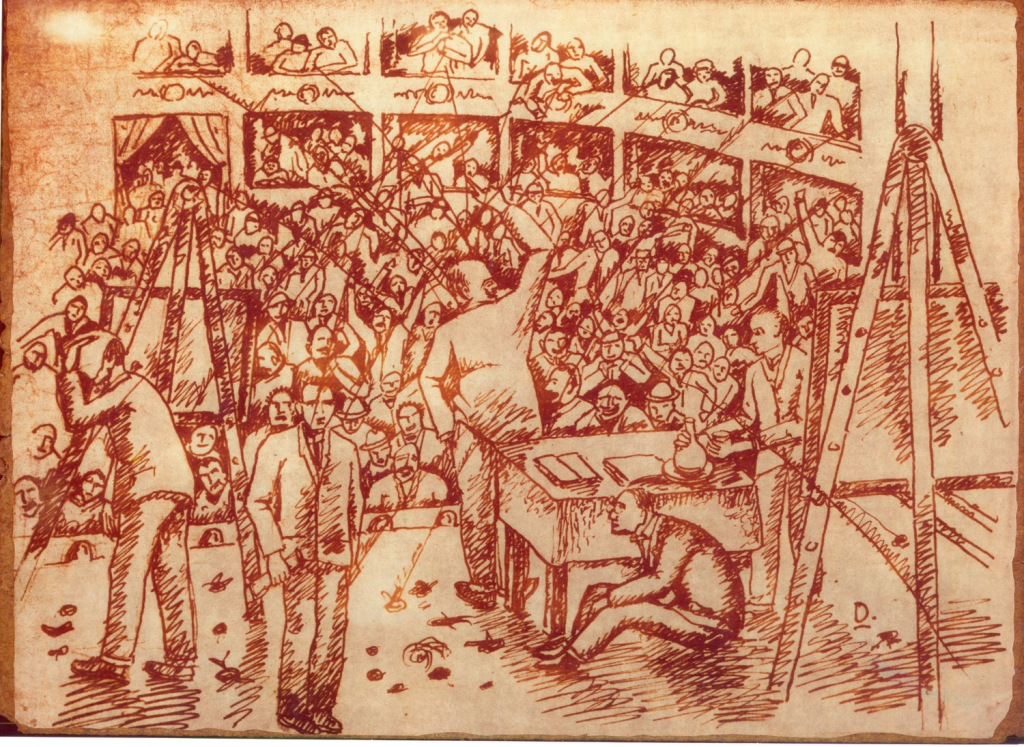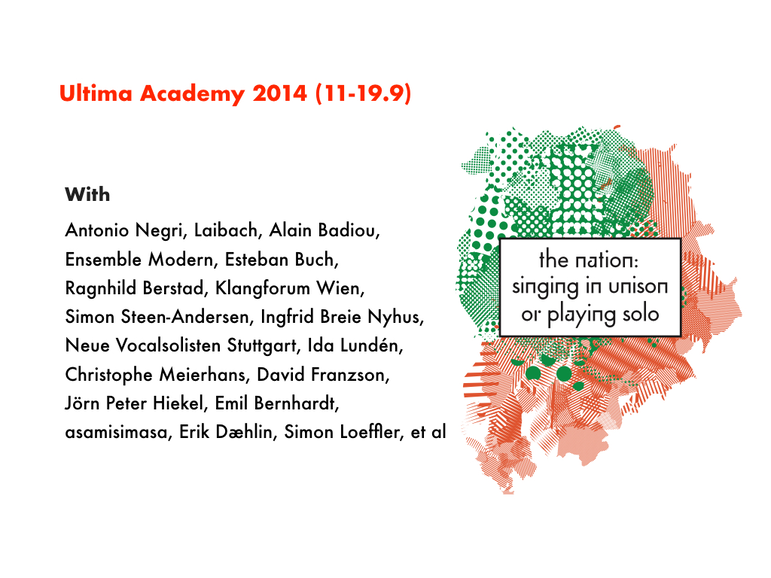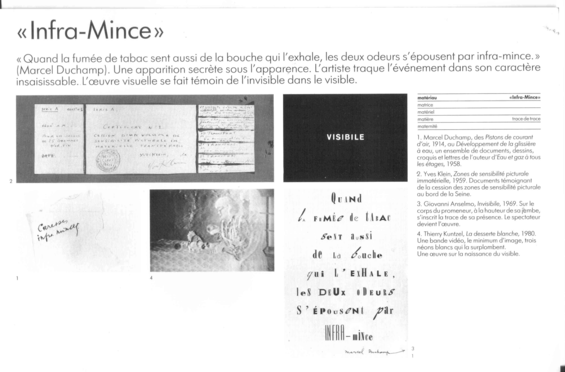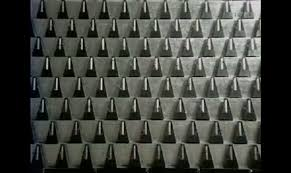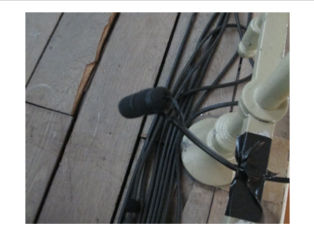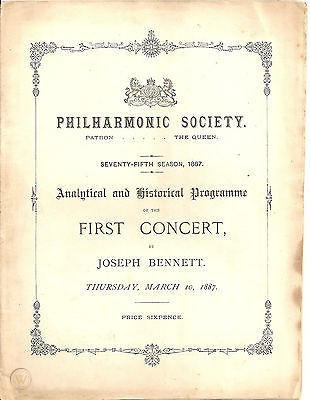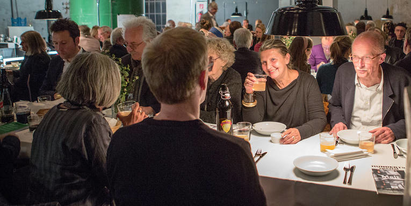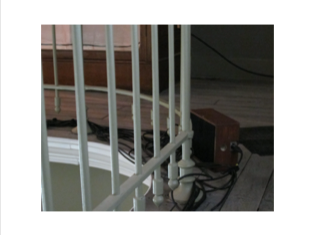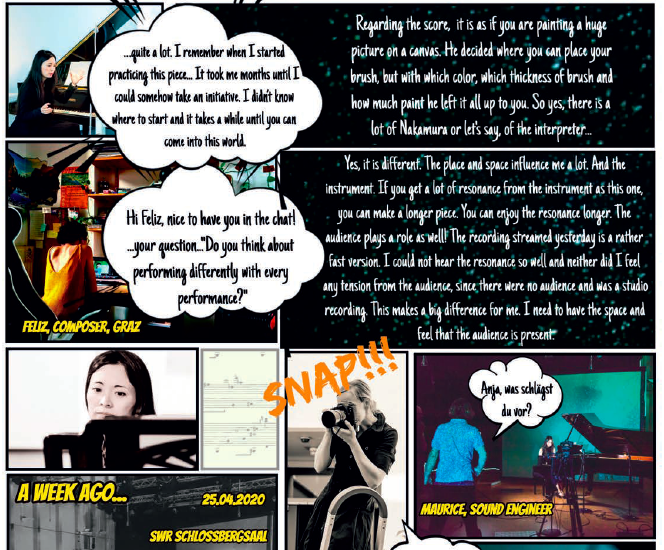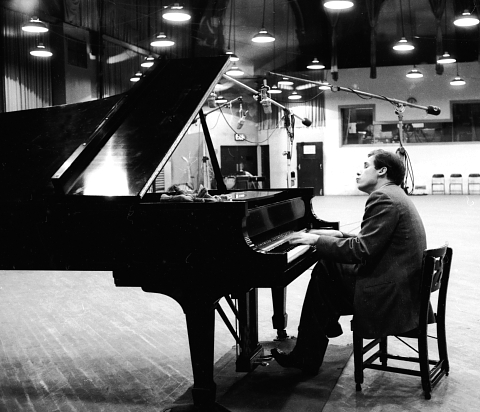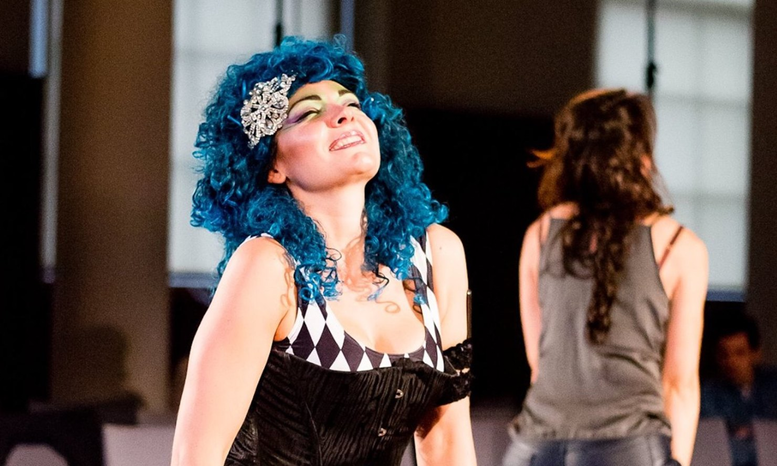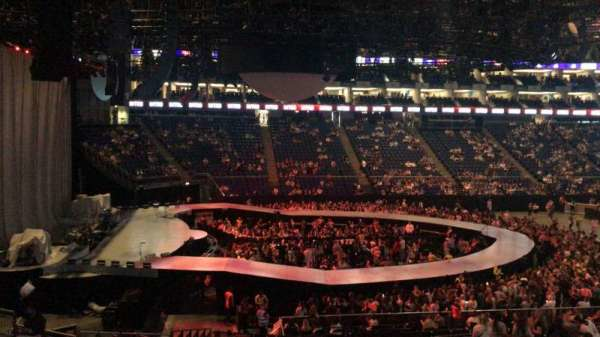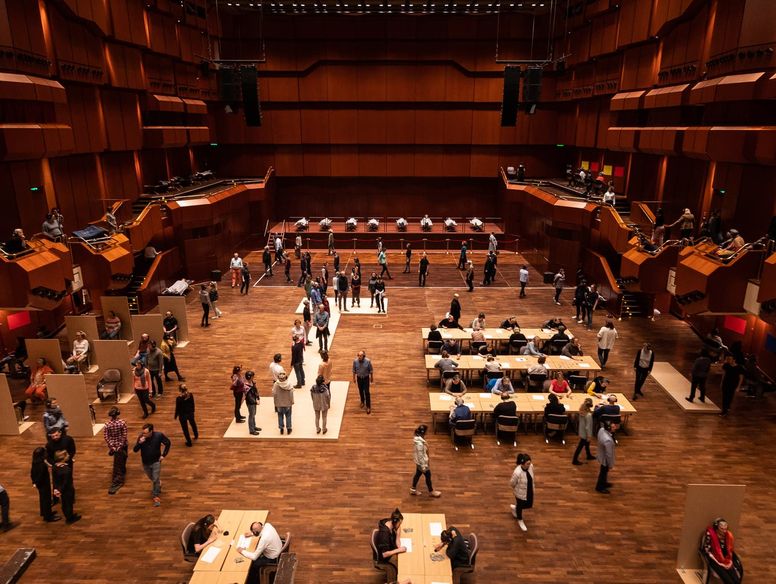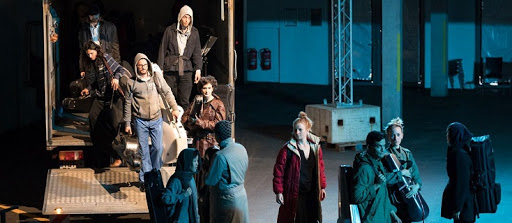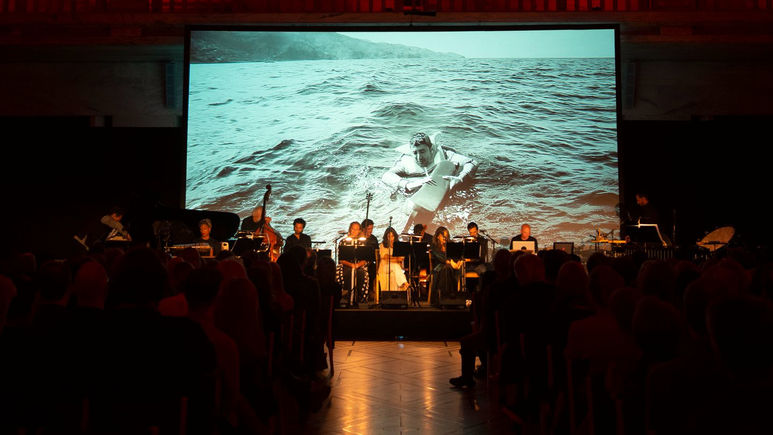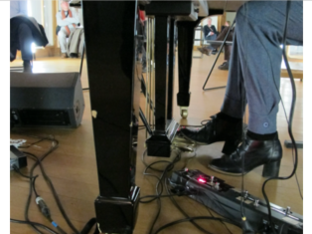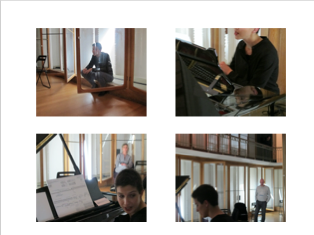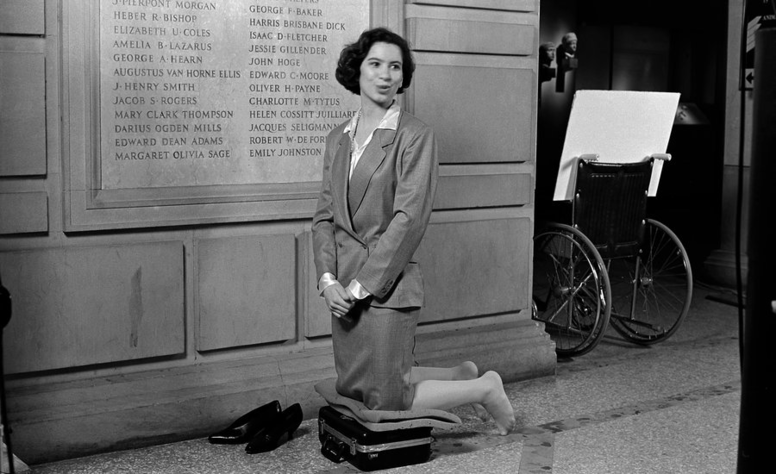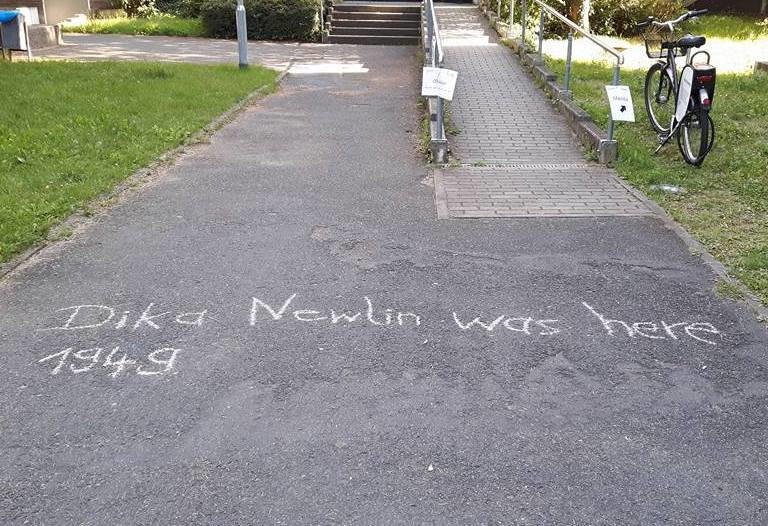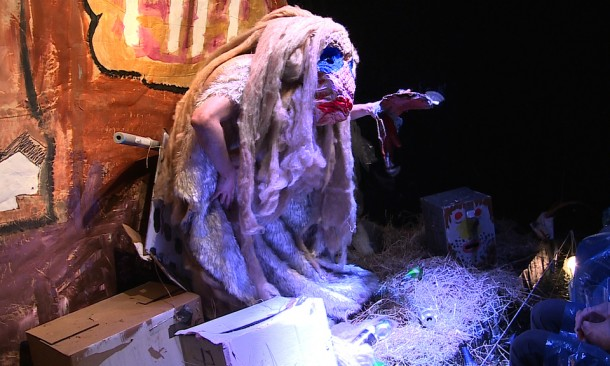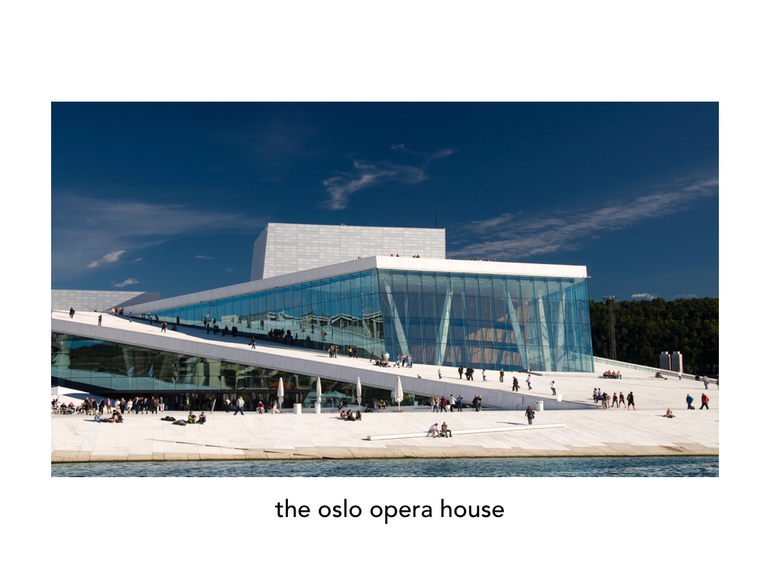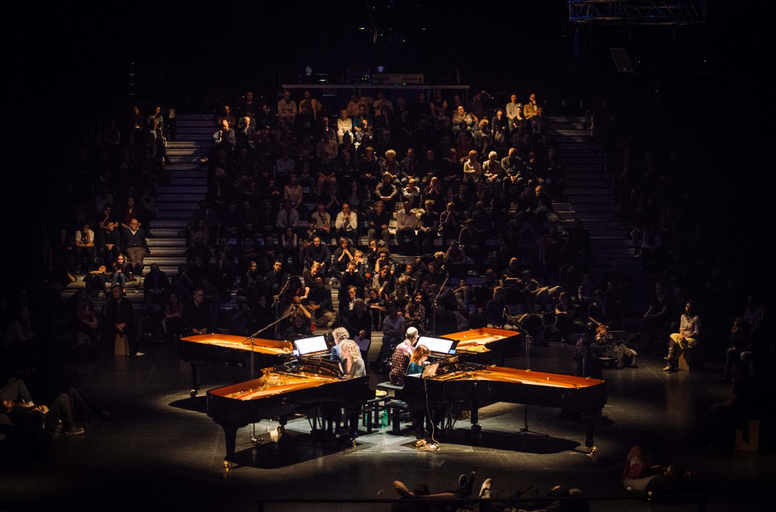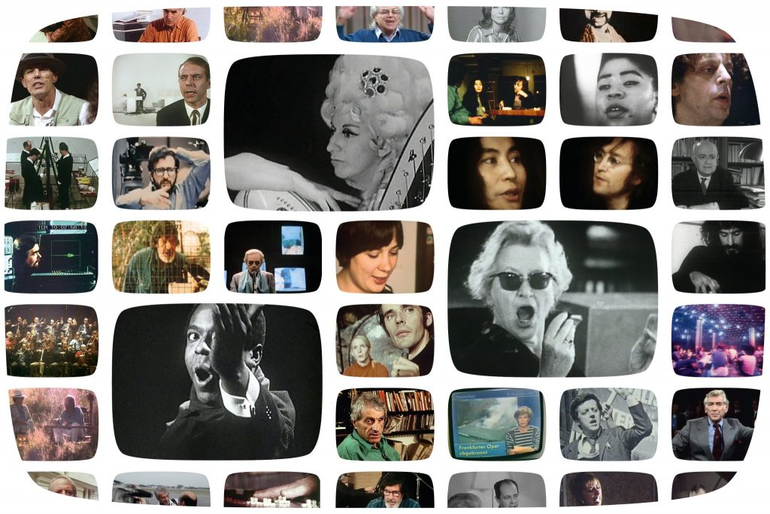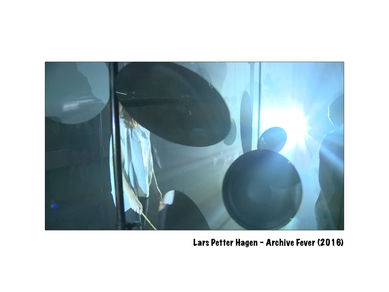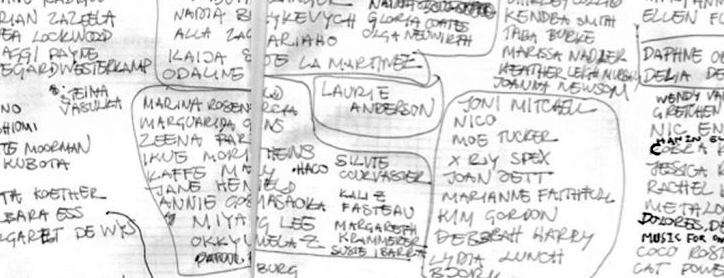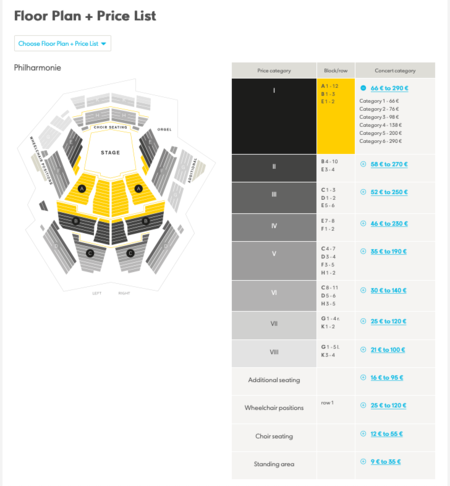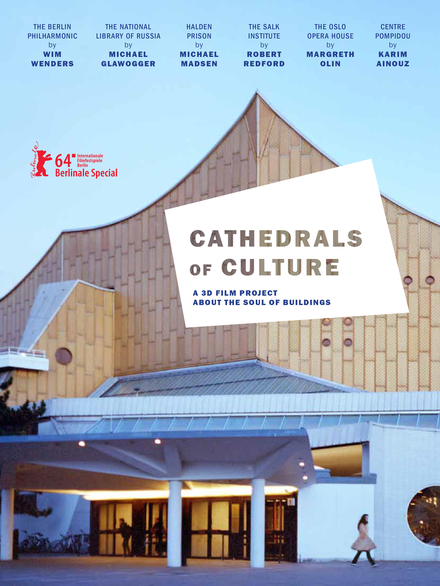Crossing Arts
Curators and artists in the search for new formats of display are often inspired by other artistic disciplines such as theatre, architecture, graphic design or the visual arts. The increasing user-friedliness of new technologies and softwares for live video, electronics and light makes it easier to integrate of non-musical elements into the context of classical and contemporary music. Arguing that a musical work is the sum of all sorts of materials related to that work, the performance Rasch 11: Loving Barthes, by the artistic research group MusicExperiment21 (ME21) combined an instrumental performance of Robert Schumman's piano work Kreisleriana with philosophical texts written about the piece, as well as with films and information emerging from musicological research or personal associations of the performers. Similarly to other projects by ME21, the resulting performance echoes the work of postdramatic music theatre directors such as Heiner Goebbels or Romeo Castellucci, who both question the primacy of the musical text by confronting it to other media such as light, props and other texts. These do not illustrate the music but rather complement, comment upon or subvert it. Violonist Nigel Kennedy also draws on theatre when integrating in his performance of Vivaldi's Four Seasons, scenographic elements such as dynamic forest landscapes. Kennedy's casual clothing and his communicative way of interacting with musicians and the audience contrasts with the formal dresses and conduct of orchestra musicians, and reflects an unpretetentious approach to the classical music world. Choreography and dance also attract musicians, as in Transit, a staged concert in which musicians from the Berliner Kaleidoskop Soloists’ Ensemble, instructed by choreographer Laurent Chétouane, performed while walking amongst sitting audiences (read more here), or in Aberrant Decodings, a collaboration between guitarist Lucia d'Errico and dancer Marlene Freitas, where Freitas embodies a listener whose body is decomposed by the musical experience. Incidentally, Aberrant Decodings also experiments extensively with graphic design: the fonts of the text projected behind the performers are created for the performance and the speed of the projection is controlled by the performer along with the music.
Ideas about exhibitions and staging from the art world and theatre led Duo Hellqvist/Amaral to create the artist collective Impossible Situations (IS:CNE). With a membership including a number of composers, an architect, a photographer and a sound engineer, IS:CNE has been meeting regularly since 2016 in order to develop new compositions and to work out how to integrate them into different concert situations. We try for instance to create connections between the thematics of our pieces and the architecture of the performance space, all the while looking for greater proximity between performers and audiences. This is done by experimenting with the placement of musicians, audience, projection, cables and loudspeakers to progressively tip the customary horizontal angle of viewing towards the circular and even the vertical, as in a concert at the Zagreb Music Biennale, where pictures covered the ground and videos of imaginary concert situations (from Plans for keyboard and violin pieces by composer Øyvind Torvund). As described in the book Impossible Situations: Concerts in the Making (2020), a valuable insight acquired by us performers throughout the four years of the project is the fact that working so closely with an architect and a sound engineer completely modifies our attitude to the music, not only because we become much more aware of the interplay between us, the music, the audience and the space, them but also because we see infinitely more possibilities of experimentation in a practice that was for us until then limited to interpreting composers and scores, and mastering instrumental-technical skills.
Unstaging and Performativity
The notion of staging (or mise-en-scène) in theatre has long been connected to the representation of a text, which it supports or illustrates. It was only at the turn of the 20th century, through the work of directors such as Antonin Artaud or Vsevolod Meyerhold, that staging started to be considered as an artistic activity per se, an art that postdramatic practitioners such as Heiner Goebbels or the Wooster Group recently brought to a new level by claiming the independence of stage elements from text or plot (Heiner Goebbels likens staging to composing ‘a polyphony of signs’). Even so, staging remains associated to the creation of an artificial world, or at least ‘a place other’, and particularly so in music, where all elements of the performance including audiences, performer, lights, seating arrangements, rituals and so forth are 'staged' in a way so as to disturb to the least possible the performance of the musical work.
With non- or unstaging, on the other hand, I refer to forms of display that do not try to conceal the 'noise' of musical productions, that is, performances in which 'disturbing' elements are not made to silence or retreat. This can take various shapes, the most typical of them being acting on stage like in everyday life, both in terms of clothing, behaviour and relation to the audience. Ensemble Besides plays lounge music in the intervall between pieces and Ensemble neoN choreographs stage shifts, particularly lenghty and complex in contemporary music productions, thus highlighting the 'working' and technical aspects of the concert. In the productions of Impossible Situations, we make stage-inherent elements such as cables, mixers, scores or projectors 'extra visible' in our scenography to show how practical, technical and aesthetic elements entangle in the making of a concert; else we fill the stage with mirrors that give more visibility to small but significant visuals details of the music-making. We also invite our audiences to visit our set-up and to take part in open workshops (see Discourse). In Voyage au bout du piano, a contemporary piano event organized biannually at De Bijloke, scores of the pieces programmed that evening and other performance material were exhibited outside of the concert for audiences to listen and see in the intermissions. The material was shown in a space called 'clicktrack corner', in reference to the in-ear metronomes used by contemporary musicians to keep the beat and/or synchronise playing with video, electronics and tape. The clicktrack corner offered a rare insight into a phase of the performance normally concealed from the audience, as did Chloe Abbott's performance of Berio's trumpet Sequenza at the final concert of the seminar With and Beyond Music. Abbott had annotated the score beforehand, highlighting passages that she considered important and writing personal comments such as reminders and expression marks that could be understood both by musicians and lay persons. this information was shared with the audience through the scores projected behind her; a simple curatorial artifice that produced very personal results. Unstaging might also mean purposefully subverting ritual markers, as in MusicExperiment21's Rasch, which starts before the audience enters the hall and finishes after musicians have left the stage, thus avoidig the final applause. While the audience tends to react positively to the immersive sensation caused by entering an ongoing performance, the absence of applause elicits mixed reactions, most likely due to the listeners not always knowing how and where to channel the energy, enthusiasm or frustration provoked by the performance.
Beginning and end, rehearsal and concert, reality or the stage, proximity and distance, audience and spectator, work and process, hiding cables and making visible the materiality of music-making; these are dichotomies, or as Fischer-Lichte would say, binary oppositions, that have until now and to a great extent defined classical and contemporary music performance. In the examples above, we see these oppositions collapse, and the focus move from the music only, to the concert situation as a whole. With this new awareness comes an interest for the potential meaning of the elements involved in a performance, i.e., an interest for what they can do; in other words, these elements become performative.
New technologies and space acoustics: SoundSpecific:Oslo
SoundSpecific:Oslo is a concert-concept combining sightseeing and sound technology. Developed by saxophonist Bendik Giske, composer and 3D-sound specialist Natasha Barrett and myself in 2012, during my tenure as guest curator for the Norwegian New Music Association, the purpose of the event was to introduce the audience to non-musical spaces with unusual acoustic properties through performances that would underscore these characteristic acoustics. In addition, we wanted to use the occasion to explore how our perception of a city is tied to our auditory memory. It proved complex to get access to many of the locations we had in mind, either for logistical reasons such as security and physical difficulty of access, lack of clarity about administration and proprietorship of abandoned or semi-abandoned spaces, or regulations concerning the use of public space. After an intensive period of venue scouting, we settled on two spaces in the city centre: the first was the western entrance hallway to the National Theatre Train Station, a place crossed daily by thousands of commuters familiar with the astonishing flutter echo caused by the circular geometry of the site. The second space was an underground storage room belonging to the national train company. Located inside of a grotto underneath the same train station and made accessible to the audience from the street through an emergency exit, this cave-like room was known only to a few, and exhibited highly reverberant acoustics typical of caves. After guaranteeing access to these two locations, engaging security personnel and studying safety protocols, we decided on a date for a one-day event featuring concerts with Giske and Barrett in these two spaces. The concerts were integrated into a city walk labeled as a soundseeing. During the concerts, Giske improvised on the saxophone while Barrett manipulated the acoustics of the spaces. Using a sound processing technique called Higher Order Ambisonics, she transformed the space into a three-dimensional sound environment that interacted with the sound of the saxophone as if it were a musical instrument. The soundseeing was followed by a concluding performance in the office spaces of NyMusikk, where we digitally simulated the acoustics of all of the spaces visited earlier in the day.
Curatorial Challenges (2): Curating Acoustics
Natural or domesticated listening
As art theorist Jérôme Glicenstein warns us, over time and through complex processes of domestication happening within and outside of the concert, the bodily techniques, rules and expectations of the concert hall have become second nature, so much so that we are generally not aware of how they our shape musical experience. The same happens with the way we listen to music. From the day that the first public concert halls were constructed in the 18th century, architectural acoustics as a musical discipline has evolved drastically, with most improvements from the shoebox-shaped concert hall to modern surround one aiming at optimal reverberation, distincteness of sound as well as a sensation of proximity within an enveloping sound environment. All of these parameters have become standardised,so that we at times forget that the way we listen to classical music in the concert hall today is not a 'natural' way of listening to music, but the way master acousticians like Yasuhisa Toyota (responsible for the acoustic design of the Elbphilharmonie in Hamburg and the Walt Disney Concert Hall), and many before him, have thaught us to. In any case, the habitual acoustic conditions of most concert halls can be said to 'frame' our listening and is less spontaneous than we believe. Site-specific projects like SoundSpecific:Oslo, concert walks and other formats in which acoustic conditions are at times random or different than those of the concert hall, where listeners move around and do not sit facing the musical source challenge our habitual mode of listening to classical and contemporary music. The same is valid for initiatives such as the ones described in Display, and where we find the traditional concert hall reconfigured. That is why visitors familiar with concert hall acoustics tend to get disappointed or irritated when listening to familiar music in other environments, where diffusion is perhaps less precise or not as immersive. Younger listeners more familiar with alternative modes of listening such as for instance, listening through headphones or low-fi media such as mobile phones tend therefore to be more open to innovations in this terrain. Developments in sound spatialisation in musical composition and the emergence of sound art (a discipline ultimately concerned with finding new ways of positioning sound in space) contribute to opening our perception to different or less common modes of listening and may inspire curators to offer new listening situations for music of the past.
Sound Leakage: Pestering or pleasing?
Proper isolation is yet another recurring concern in the context of musical performance (especially in non-musical spaces) and sound art exhibitions. However, while much effort is put into preventing outside noises to penetrate spaces of performance, acoustic leakages in sound art displays are generally considered less problematic, most likely because sound art as an art form has developed outside of, and often against, the polished acoustic aesthetics of the 19th and 20th century concert hall. In major sound art exhibitions such as Soundings: A Contemporary Score at the MoMa in 2013 or Sound Art at the ZKM in 2012, works contaminated each other aurally, and the same is valid for recent performance projects in art galleries such as the Kunsthalle for Music. The last project in particular invites us to consider a more contemporary mode of listening in which sounds from different sources coexist, with the choice given to the visitor to select, focus or zoom out listening at wish, thus replacing a ‘high-fidelity’ mode of listening with, to use the expression by of music curator Monika Pasiewickz, a ‘listening with deviations’.
Display refers to the way the various elements of musical performance are arranged in time and space, including concert rituals, choice of repertoire, a specific choreography, lighting, the position of the audiences, the duration of the performance and so forth. Concepts of display vary according to the context of presentation and the role attributed to art within a given place and period. In places with strong representational function such as public museums or concert halls, they often carry symbolic and ideological weight. For instance, in the classical concert, defined by Hanns-Werner Heister as a 'place of realisation of autonomous music', musical works and the way they are performed are traditionally at the centre of the event, with elements such as the stage, the silence and composure of audiences, the order and length of the repertoire, the architecture of the concert hall, its acoustics, and the spotlight on the performer contributing to highlight the music and its performance. Although concepts such as staging or 'mise-en-scène' could be used more or less interchangeably with display, I like how display refers to museum vitrines, shelves and cases, and more broadly to exhibition-making in the visual arts, a process similar to concert-making both historically and in practical terms. Historically speaking, display points indeed to an authoritarian mode of experiencing art typical for the 19th century, more specifically, to the way artefacts in museums or objects in window shops are brought to view as a commodity to be admired and consumed ("look but do not touch!"), the same way musical works are objectified in the traditional concert situation. However, if we look at display in an etymological and musical way, it becomes much more imaginative, dis- as in 'un-' or 'apart' + play as in 'playing music or an instrument' suggesting a mode of curating in which things and traditions can be taken apart, displaced, given new meanings; in brief, played differently. In the case of the classical concert, dis-playing might mean the reconfiguration of peripheral elements or the inclusion of new elements in the concert situation: new roles for audiences and musicians, exploring the digital, exploded time frames, using film, light or text, among other strategies to tweak traditions and explore alternative modes of experiencing music and art.
An aesthetic gaze
In addition to showing music from a new angle, performances outside of conventional concert spaces can cast new light onto places not normally associated with art. An example is the opening concert of the Borealis Festival 2013 in the recycling plant BIR in Bergen. Curator Alwynne Pritchard’s idea of placing the opening concert of the festival in such an unorthodox place related to her long-term project of involving the city of Bergen, its places and inhabitants in the becoming of the festival. Also, the decaying waste and its transformation in the recycling plant perfectly embodied the theme of the 2013-edition, The beginning of the end. The music presented at BIR included A House and a Melody by Øyvind Torvund, featuring Brahms’ Lullaby played on a white harpsichord placed in front of floor-to-ceiling windows from which the audience could see a massive crane gathering waste from a junk-filled yard. The piece manifested a double transfiguration: a transfiguration of the music and its performance traditions, made older by the choice of instrument (the piece is not originally written for harpsichord), a choice further emphasised by the presence of the collapsing junk; and at the same time, a transfiguration of the place through the aestheticisation of its its waste, made beautiful by the sadness of the music and its slow pace, which coincided with the ponderous movement of the crane.
Another case in point is the outdoor multimedia concert Dead Serious by Ensemble Nadar in the Georg Büchner Square in Darmstadt in 2014. Dead Serious was centered around a piece by Michael Maierhof composed for four hot air balloons. Nadar’s performance was, in the words of the ensemble, ‘to be situated somewhere in between concert, immersive installation and political performance, with “surveillance” and the related blurring of the borders between reality and virtuality as recurring themes’. Once used for espionage, hot air balloons alluded in this project, to modern forms of vigilance. During the performance, the rhythmicized sounds of the balloons being blown up were accompanied by instrumental interventions by the musicians, who were placed around four large screens showing footage taken during a balloon flight over the city. The audience was invited to walk around with modern drones flying overhead. With over 3000 visitors, Dead Serious checked all the boxes of a successful outdoor commission: it included an acoustic experience unimaginable in concert hall conditions; created a dialogue with the surroundings, both through the footage of the flying balloons and the presence of the musicians and balloons in the square; last, because of its central location in the city centre, it exposed local audiences to contemporary music.
New Formats, New Rituals
The generic classical concert model consolidated in the late 19th and early 20th century lasts for about an hour and a half including a break for refreshments; well-known repertoire is presented in a specific order (for instance, in the case of an orchestral concert, an overture or similar, a solo concerto and a symphony, a model copied and adapted to recitals, conservatoire examinations and competitions); audiences are silent and seated, applauding when musicians enter the stage and before they leave it, among other particular rituals and markers such as the bells announcing the start of the concert or the end of the intermission. ‘Stepping into a hall today to hear a performance of classical music commits the listener to a strict social regime. One is expected to abstain from any undue movement or speech and to listen with what James H. Johnson has called 'absorption', that is, complete attention to the music’, writes music historian William Weber, describing the listener as an austere body conditioned to silence at the sound of music, signalling therewith introspection and his or her respect for the greatness of art. Sociologist David Ledent notes how applause, appearing in the concert hall around the 1820s, was used in the concert to reconcile individual and community, for it allows the spectators to collectively release the emotional and introspective experience of the music. Its symbolic function turned applause into a highly codified insider business, as illustrated by a humorous chart published by the ticket-selling agency Ticketmaster in an article directed to classical concert – neophytes (see picture). According to performance theorists Erika Fischer-Lichte, such rituals, as well as the fact that performance takes place in a dedicated space, contribute to detach performance from the continuum of the everyday, a detachment that is necessary for unleashing the healing, bonding or uplifting dimension of performance. However, we will see in the examples below that artists nowadays are looking for a type of transformation that happens not outside of, but within the continuum of the everyday.
From rock to contemporary
Ensemble Ictus’s Liquid Rooms are informal performance situations inspired by rock festivals and improvised gigs. Inside of a Liquid Room, music is performed for several hours in different parts of the hall. Lighting effects (blackouts, strobings, projections) and 'instantaneous productions' (improv and remixes of performed works) ensure a smooth and unbroken transition between the many stages and pieces, the latter chosen for their cool, ambient and/or hyperenergetic nature. The audience is invited to move freely within the concert space, entering or leaving it at will. In brief, a situation very different than the one portrayed on the picture of pianist Sergey Rachmaninov, where a formally clothed and sitting audience listens in reverence to the likewise formally clothed pianist on stage.
Closer together
In a similar vein, the Brussels Philharmonic invited listeners to seat in deck chairs placed amongst the members of the orchestra in a series of concerts featuring music by Ligeti, Gabrieli, Wagner and Iannis Xenakis. This seating position was determined by Xenakis, who wanted the audience of his piece Terretektorh to become part of the orchestra machinery and to experience closely how the movements of the musicians influenced sound production (the title of the piece comes from the Greek and means 'drilling holes', which the audience literally did by trespassing the boundaries of the stage and mingling with the performers). The idea of extending it to the rest of the programme, however, was very succesful in what regards bridging the distance between stage and listeners. This concert brings us back to Pierre Boulez, who during his tenure as music director of the New York Philharmonic in the early 70s, replaced seats with comfy mats in his famous “rug concerts”. In addition to being convivial, these concerts had an egalitarian purpose: since all tickets were sold for the same price, rich patrons and common audience were for once encouraged to sit side by side.
Liberated from the score
Feeling that conventions such as seating and performing from scores on notestands restrained their musical expression and the ability to make direct contact with the audiences, the Norwegian Chamber Orchestra decided to perform Grieg's Holberg Suite by heart and in standing position. Far from exhausting, musicians found the fluidity of these new standing position liberating. They lost themselves in the music, which the audience partook in.
Silence Thematised
Some of the rituals of the traditional classical concert format can be commented upon through musical compositions. In John's Cage 4'33 from 1952, performed here by David Tudor, the pianist enters the stage, bows, sits at the piano, turns the pages of a score at regular intervals, stands up, bows once more, and leaves the stage without having played a single note. The absence of music brings new perspectives to the rituals of the concert format, which appear theatrical, to say the least. Besides highlighting concert rituals, the piece directs attention towards the noises produced by the audience. With the silence of the pianist, these noises ‘become’ the music. This change of perspective leads the audience to reconsider their own position in a situation otherwise dominated by the voices of those on stage.
Temporal ruptures
The radical juxtaposition of older and new works shows that correspondences between past and present might be less linear than those suggested by conventional music history, as we can hear in the ever more popular concerts that do not follow the stepwise chronological programming from Baroque to Classical to Modern and Contemporary. Markus Fein describes a concert at Summerly Lusic Days Hitzacker in 2004 featuring a string quartet by Luigi Nono alongside madrigals by Gesualdo und Luca Marencio, performed, incidentally, by two different musical formations, a choir and string quartet.
Curatorial challenges (I)
A mini-case study about the creation of a site-specific project: OurEars by Ensemble Nadar
OurEars (2018) was a series of concerts designed by Nadar and guest composers specifically for private locations in Darmstadt including an artist’s studio and the house of a sculptor. The audience was invited to experience the music through the imaginary eyes and ears of the buildings’ inhabitants, whose life stories we could reconstruct from photos on walls, personal objects, biographical notes in the programme booklet or recorded interviews aired during the events. OurEars was inspired by Chambre d’Amis, an iconic curatorial project developed by visual arts curator Jan Hoet in 1986, for which Hoet had asked artists to create work for inhabited apartments in the city of Ghent. He describes such practices as a displacement, or the curatorial act of disrupting perspectives by shifting things out of their usual physical places.
Curatorially speaking, site-specific projects such as OurEars involve numerous challenges. Not only might it prove complex to get access to the venues as described above, it is also not simple to communicate the event and the rules of an unknown place to the audience without mitigating the surprise-effect of the site or being too didactic towards the visitors. It is necessary too, to reflect about ethical aspects concerning the position or role that the daily users of the site will have in the performance, or to be prepared for their reactions if they feel threatened or disturbed by it. (A relatively innocent example is the case of visitors planning to eat lunch undisturbed in the Riverside Terrace Cafe at the Southbank Centre in London in a September afternoon, and who find themselves listening to a brass quintet performing new Swedish compositions as part of the Nordic Music Days 2017. More complex situations are concerts in places such as prisons or hospitals. In these places, the local ‘audience’ does not necessarily have the chance to choose whether they want to listen to the music or not. If not thoughtfully prepared or motivated, the performance might be soothing for some but irritating for others.)
Another point of consideration are the shifts in different modes of listening within a short time span. Theatre director Richard Schechner describes site-specific performances as 'constellations of rhythmically organized events', combining controlled time (performance time which calls for focused attention) and informal time (time to move between space, breaks, etc.) differently and more loosely than in the structured sequencing of event of conventional concerts. An ongoing negotiation arises between artists and audience about how to move in this new time-space structure, between freedom and guidance or structure. At OurEars, the concert inside the sculptor’s house was very relaxed; there was no sensation of centre-stage and we could move freely within the interior of the house. At the same time, some of the performances that took place therein (f.ex. a performance by Cathy van Eck) required a concentrated form of listening, which arose organically through the way the musicians narrated the spaces and their performances, rendering the shifts between different modes of listening effortless. In the artist studio, by contrast, there was much more guidance from the musicians, who constantly informed us of where to go and what to do, with concerts in different spaces in and around the house; for the audience, this created the uncomfortable alternating sensation of moving inside an orchestrated choreography, or being a puppet on a string.
How to prepare the audiences for performances in unconventional concert settings and how to communicate with the audience during the performance? A quick glance at the announcement of the production on the homepage of the Summer Course for New Music Darmstadt 2018 (my italics) tells a great deal about how well the ensemble had prepared visitors for the rules of these new spaces already before the event. Firstly, the secretive dimension of the project is revealed through expressions such as 'for a few listeners’, ‘need to register’ or ‘undisclosed locations’, which were meant to attract audiences but also to protect the privacy of the homeowners. More generally, their choice of verbs ('to experience', ‘curating’) alerted one to a sensory experience that would include more than just listening. As a final note, an invitation to meet the musicians ‘over a drink’ after the final concert (which turned out to be impossible, because unlike the mini site-specific concerts, the final concert in a well-established concert venue was overcrowded with over 500 visitors) hints at a yearning for informality and suggests that the need might arise for a collective digestive experience, that is, for making sense together of an event involving such different and unusual modes of being and listening.
All artists are alike. They dream of doing something
that’s more social, more collaborative,
and more real than art.
Dan Graham
Why signing up?
With and Beyond Music is the seminarI began teaching in 2017 at the Royal Conservatoire. Open to master students from all departments, With and Beyond Music introduces students to practices of curatorship in music and other art forms. The course is built around six main topics: display, context, discourse, audiences and social engagement, as well as management and production (not included here). It is the combination of these six aspects that differentiates curating music from performing or arranging musical events.
The notion of curatorship entered the visual arts around the 17th century. For a long time, curators have remained in the backstage of the art world, in charge of interpreting and documenting the artefacts of private or public art collections. However, transformations in the art scene in the second half of the 20th century have progressively brought the figure of the curator into the limelight, giving it a more public, social and creative dimension. After the second world war, new roles were sought for art within a society recovering from the social and political upheavals of the previous decades. Artists rebelled against the prevailing tradition of autonomous art, creating new forms of artistic expression no longer based on static canvasses but on self-reflexive dialogues between people, ideas and a great variety of media. Affected by this new attitude, institutions grew more aware of their social responsibility and started questioning both their own political and ideological motives, and the nature of their relationship with their audiences. Curators became responsible both for accommodating emerging art forms within and outside of traditional exhibition spaces, and for mediating between institutions, artists, audiences and society at large.
Today, the work of curators has become all-encompassing: curators are scenographers (developers of visual design), choreographers (architects of movement in space), conductors (masters in finding balance and right intonation), theatre directors (who supervise an action), filmmakers (producers of montages), writers (communicators of ideas), dramaturges (who contextualise and connect text, audience, actors, environment), philosophers (who think in concepts) or even diplomats or politicians (mediators or gatekeepers of the cultural sphere). Assuredly, curating requires skills belonging to each of these competences, in addition to know-how in management, accounting, production, networking and fundraising.
It is sometimes said that when other arts transform, classical music is slow to follow suit. For instance, sociologist Hans Abbing describes the classical concert scene as ‘museimified’, noting how pop and rock musicians, often educated elsewhere than in music conservatoires, are more open to innovation than their classical peers. When asked about their motivation for signing up to my seminar, students referred to the need of ‘breaking the bubble’ of classical music and ‘rebelling against conservatism’, ‘of blurring the borders between in- and outside’, or even ‘getting out of music’. In contrast, they clearly wish to create and perform music in ‘alternative settings’ and ‘different social environments’, to ‘connect to a community’, convey ‘social emotions’, ‘make a difference’ and ‘respond to various sociocultural situations’. They long for impulses from other disciplines and other forms of art; to explore new technologies and more accessible media such as YouTube; or to engage with ‘performance practices that do not involve my instrument’. In short, they are yearning to connect.1
In this yearning, they are not alone. There are indeed many who voice their concern for the decreasing audience numbers in classical and contemporary concerts, and for the rigidy and elitism of the format, among them audience researchers, cultural theorists, funding agencies and cultural institutions. Surveys show audiences thirsty for cultural experiences but for whom the raw exposure to musical works is either too unfamiliar or not stimulating enough. No longer satisfied with merely executing scores, professional musicians and ensembles also search for ways to think beyond interpretation and the musical work. Progressively, diversity, outreach and sociality become hot topics in the classical and contemporary music scene, with many programmers striving to more accurately mirror the pluralism of today’s society in the activities they propose; audiences become increasingly involved in the making and the performing of musical events; performers and curators (or performer-curators) design original and socially minded strategies to make the concert format better oriented towards interactions with society – for instance, curator Markus Fein describes the ‘concert of the future’ as including cross-disciplinary experimentation, a social dimension, choreography and stage design.
Nevertheless, if examples of practices abound, they are not yet fully institutionalised and neither have they wholly entered the universe of musical education. Indeed, when I defend the use of the notion of ‘curatorship’ in music with colleague musicians, I am often met with a certain resistance. Curating has become so fashionable a term in recent years, that it has started to sound shallow. Used ubiquitously to refer to the artful organisation of practically anything, from exhibitions to menus and playlists, from social media profiles to shopping lists and supermarket displays, 'to curate' has, in our consumerist society, become a way to add value to something, make it special, and therefore more desirable. Following the same logic, curators, and in particular those operating in the more cash-flushed spheres of contemporary art, are associated with the high-life, vernissages and the jet-set. Calling oneself a curator nowadays is a ‘power move’, says media critic Simon Dumenco. Star curator Hans Ulrich Obrist recognises how his profession evokes, in the imaginary, ‘the contemporary idea of a creative I, floating freely across the world and making aesthetic choices about where to go, what to eat, dress and do’, an idea that cosmopolite Obrist personally contributes to create. More than just a branding strategy, though, 'curating-mania' (a term by art critic David Balzer) is a complex sociological phenomenon that deserves to be taken seriously. For we no longer live in a world which we can survey, know and transform, but in a world that is unpredictable, a world where images, information, ideas, knowledge and products proliferate. In this world, in which we find ourselves easily lost and disorientated, 'the possibility of rewiring relations', to quote media theorist Marie-Luise Angerer, becomes all the more important. Curating does just that: it provides context, situates and relates artworks, people, places, spaces and ideas, among other things.
In the arts, curatorial practices have expanded greatly in recent years to the point of having become an academic discipline in their own right. Over time, with the work of curators informing that of artists and conversely, a feedback loop was established between the two professions, so much so that we, today, speak of artists who work like curators, using strategies inspired by exhibition displays in their own artistic work; of artists working as curators, using their artistic experience to curate art shows; and finally, of curators working like and in some cases as artists, using strategies inspired by art to curate events at times considered as artworks. Yet another characteristic of the recent curatorial turn is an increased focus on the connection between theory and practice. Curating reflects on the why's and how's of showing art in a particular way, and is therefore concerned with making visible the processes involved in making and displaying art; hence its particular interest for presentation formats that self-reflexive and discursive, or constructed through and with research. As a result of such crosspollinations, the borders between art production, display, discourse and rsearch become ever more blurred. Drawing on this blurriness, I present below examples of curatorial practices which will hopefully inspire readers, students, professional artists, curators, researchers and teaching colleagues alike, to experiment with presentation forms and formats, as well as to more firmly ground curatorship as a discipline within the music field.
Technologies, Architectures and Presence
In the search for connections between the closed world of the concert hall and outside world, artists employ a variety of technologies such as a videophony and field recordings to let the outside in (to make the real 'irrupt into the stage', to use an expression by postdramatic theatre theorist Hans Thies Lehmann). This was the case of my Interferences-project described above. Another example the staging of Gluck's Orpheus and Eurydice by Romeo Castellucci. During the first act of the opera, a soprano sings the tragic tale of Orpheus and Eurydice. Projected behind her on a gigantic screen is a text that retraces the life of Els, victim of locked-in syndrome. Twice a day, so the text tells us, Els’s husband rides his bike to where she is hospitalised, dreaming, like Orpheus, to bring his wife back home. Halfway into Els’s story, a live feed transports us to a clinic in the outskirts of Brussels. There we meet Els in her bed, watching us without being able to move or speak. As the camera comes closer, it reveals every single line of her face, making her presence in the concert hall become enormous. The reason for this enormity is twofold. To start with, Castellucci astutely architected the encounter with Els, capitalising on music, dramaturgy, setup and myth alike to enhance the emotional impact of her virtual appearance in the hall. Then, there is the insidious nature of reproduction technologies. Reproduction media, even though they mark a clear separation between viewer and viewed, transgress the function of the stage by giving the illusion of a greater proximity than could be achieved in real life. As is known from cinema, we see better through the eyes of the camera than through the bare eye. A famous example are the faces of Ingrid Bergman and Liv Ullman in Autumn Sonata, made intimately known to the viewers through the close-ups of the camera. Had it not been for this sensation of proximity, the view of Els would probably have moved us but would have remained more associated to the myth than to reality. As it was, however, the reality of Els swallowed up and the drama and the concert hall.
Still on the topic of how technologies influence musical display, the 'non-human' expressivity of loudspeakers has a great visual impact, which is being increasingly acknowledged and explored scenographically. In Stifters Dinge by Heiner Goebbels, a 'performative installation without any performers' including among others sound sculptures, texts and excerpts of existing works, light is placed on the loudspeakers as recorded voices are played back, giving the speakers a uncanny human-like character. The interest for the visibility of speakers stands in contrast with the conventional definition of acousmatic music as music 'for the ears' only. This idea originated from a long-standing habit of performing this music in darkness, a habit due to a great extent to the fact that loudspeakers, in contrast to the charismatic presence of live performers, are considered by many as neutral sound vessels. Acousmatic music lovers saw the neutrality of speakers as a strength, for it provided a counterpoint to the mannered attitude of classical musicians.
However, the absence of the visual presence of performers in acousmatic concerts led also to more interest for the space of perfomance, as show experiments at the intersection of music and architecture/space such as the Philips Pavilion, constructed by Iannis Xenakis in 1958 for the performance of Poème Electronique by Edgar Varèse, and in which visitors were invited to a parcours including numerous speakers, light effects, video projections and hanging objects. The same Xenakis composed a series of pieces entitled Polytopes, which combined music, lights and architecture, but these are original works, and not new stagings/displays of existing works, which explains why Polytopes and a wealth of musical composition involving space, other art forms, special forms of display and new technologies are not included here.
Site-specificity: from the visual arts to music
Increasingly, music is composed for specific environments outside of the traditional concert hall. To work site-specifically came into fashion around the 1950s and 60s, as visual and performance artists rebelled against the then popular white cube, neutral environments which, according to them, obliterated previous attempts at contextualising artworks and de-sacralising the exhibition space. Against this background, many artists fled art institutions in favour of locations which would provide new contexts for their work. One of the first major examples of site-specific art is Robert Smithson's Spiral Jetty from 1970 at Rozel Point Utah, made with black basalt rock, salt crystals, earth, and water of the Great Salt Lake. A while later, the trend affected theatre, dance, and more recently, music, where it takes two forms, the one being musical compositions created for specific sites, and the other, the presentation of existing works adapted to a given site. Site-specific composition is a major theme nowadays, with historical precedents including electronic pieces by Karlheinz Stockhausen such as Expo from 1970 and soundscapes by Murray Schaefer or Hildegard Westerkamp.
New spaces, new rituals
As I mentioned above, there is a growing tendency for music to move from established concert halls to less conventional performance spaces, the nature of which may vary widely and encompass anything from shops to factories, galleries, office spaces, public pools, forests and shopping malls, all depending on whether the performance is meant to 'meet the audience where they are' or to propose an experience out of the ordinary. Performances in unusual spaces can create connections between music and the everyday, making music less dissociated from the daily life of its listeners. Also, they break with the conventions of the concert situation. While certain rituals, such as applause or a demarcated stage, might be carried over to places other than the concert hall, these places contain their own rules, which might be accepted, adopted, explored, subverted, broken or even erased.
Yellow Lounge
Organised in popular Berliner clubs by the Deutsche Grammophon label, Yellow Lounge evenings adapt classical music to the taste of the clubbing audience. Playing for a dancing audience, before and after the evening's main act (which includes big names of classical music such as Anne Sophie Mutter or Milos Karadaglic), Yellow Lounge DJs remix classical works, adding beats or bass to the music, playing with tempo, and letting it run very loudly through club speakers until the early hours of the morning. Transforming the music in this fashion is a rather radical move in a classical world that generally does not dare to touch its 'sacred texts'.
The return to the white cube
In the exhibition Kunsthalle for Music, shown among others at Witte de With in 2017, curator-composer Ari Benjamin Meyers displaces musical performance from the concert hall to the white cube. For the project, Meyers had selected a group of musicians who performed in the museum each and every day, all day, for the duration of the show (almost three months). The white walls were left empty with the exception of signposts indicating the title of the piece to be performed on that spot. Apart from that, the musicians did the work, alternating performances in the different galleries of the museum, playing soli, in small groups or as a whole ensemble. Since the performances were unannounced, the audience had to move around the galleries and follow the sounds to find out where to go and what would happen next. What Meyers had proposed when displacing musical performance from the concert hall to the white cube was to create a structure that would allow for music to be produced and heard in accordance with the rules of the art gallery or museum. Considering that the concept itself enacted these rules, it also succeeded in making visitors complicit with them: in a Kunsthalle, people are supposed to walk, as is suggested by the space, so if they at times sit down to enjoy a particular performance, it is a matter of choice. Moreover, the location of the project in a popular contemporary art gallery, and the fact that it was presented as an exhibition, already attracted visitors expecting to act as if in an art show. As a consequence, performances felt like tableaux vivants rather than as spontaneous musical experiences. The reception of the project was mixed, with non-music audiences ecstatic about the ‘live exhibition’ of musicians and the possibility of being so close to them, and music reviews uncomfortable with the zoological gaze of the audiences upon the musicians, and pondering about time (what happens to the duration of the piece?is it still a piece of music if it is not listened to as a whole, or does it become pure sound?) and acoustic isolation (see Sound Leakage below). Such questions challenge expectations and conventional musical markers, showing how a new context alters even the most commonplace musical parameters.
Early attempts at rethinking the classical concert format
Deviations from the standard concert format are not a novelty in music history, as concert historian Walter Salmen reminds us in his book Das Konzert. Staged concerts combining music and other art forms were already documented in the 19th century, inspired largely by Wagner's notion of Gesamtkunstwerk (total work of art). Worthy of mention are for instance Franz Liszt’s performance of his Dante Sonata in Rome in 1865 alongside the exhibition of Buonaventura Genelli’s images on Dante’s Divina Commedia: or a performance, in Minneapolis in1849, for which the painter Henry Lewis had created a four mile long panorama image of the Mississippi River that was rolled out in synchrony with the music. In Düsseldorf in 1863, Beethoven’s Pastorale was performed with the accompaniment of landscapes painted by regional artists. A machine was constructed by Otto Windscheidt to allow for change of paintings during and between the movements of the symphony. The effect was akin to a music video. With the advent of new technologies during the 20th century, the first shy attempts at integrating different art forms were replaced by impressive multimedia events, such as the 1966-Leipzig performance of the Deutsches Miserere by Paul Dessau accompanied by giant projections of war images from Bertolt Brecht's Kriegsfiebel, or multisensorial spectacles such as the open air performances of the Shiraz Festival in Iran during the 70s, or a video projection of a performance of Bruckner symphonies over the Danube in 1979.
Unique or adapted
Mixing Styles
Wishing to break down the barriers that separate musical communities, the Bang on a Can Marathons in New York feature dialogues between different formations, as well as between musical genres or established and lesser known composers. 'Their idea was simple: instead of sorting music by style, genre, or venue it would be more powerful to group music by innovation, finding the rebels in each musical community, the restless creators not content to leave conventions unchallenged. Putting all of these fresh voices back to back on one gargantuan concert would allow the audience to experience the excitement of the innovation and breadth of vision' (from Bang on a Can's webpage). Concepts such as Bang on a Can Marathons are very successful amongst both audiences and musicians, pleased to be exposed to new types of music. From firsthand experience, I was invited in 2010 to perform a piano sonata by Franz Schubert at the Grønland Chamber Music Festival in Oslo, as part of a concert also featuring experimental improv-duo Bjerga & Iversen. Asked whether I preferred to wait backstage or to listen to Bjerga & Iversen’s set right before mine, I hesitated, fearing the loss of the focus needed to perform my carefully rehearsed interpretation of the Sonata. And yet I was curious: How would the audience (and I) experience Schubert after being exposed to drones and distorted dub-samples for forty minutes? The mass of sound produced by Bjerga & Iversen lingered in my head far into my own performance, and out of it I sculpted lines and shapes with an enhanced sense of presence, as if i was experiencing the piece for the first time.
Thematic concerts
Inspired by this experience, I have recently presented a series of thematic concerts connecting different pieces under the specific subject of interferences, and in which I combine the performance of prisma interius II by Catherine Lamb with that of Bach/Brahms' Chaconne for piano left hand. In Lamb's piece, street sounds picked up in real time by microphones placed outside of the concert hall enter the stage filtered through the tones of my keyboard. For the performance of the Chaconne, I leave the microphones open, letting the street sounds interfere with the classical world. Musically, the unpredictability of the street noises, and most of all, the reciprocal contamination between present and past generates a great tension both for performer and audience, who need to constantly negotiate the focus of our listening.
Thematic concerts may include elements other than sound. In Schönberg's Memory Wheel (2016), pianist Jan Michiels created a thematic concert around Arnold Schönberg’s universe. Inspired by the Viennese composer’s interest in games, he designed a performance in which the content was determined by throws of dice. Depending on the number cast, one would hear works by Schönberg or by composers that either influenced him or were strongly influenced by him. Equally, one might see a painting or hear readings of literary and scientific texts that Schönberg greatly admired. Problematising time, acceleration and industrialisation, the Göttingen symphony orchestra organised a parcours with installations, actions, listening and film corners leading to the city's Lokhalle ('engine-shed'), where they heard among others Honnegger's Locomotive Music, Ligeti's Poème Symphonique and readings from Stan Naldony's The Discovery of Slowness.
Extreme conditions
Other formats experiment with extraordinary durations. The concert-concept The Long Now, presented annually at the MaerzMusik Festival in Berlin since 2016, breaks with traditional concert length, inviting people to spend the night, and even sleep, in the premises of the concert hall. With a duration of more than 30 hours, The Long Now explores the notion of music as a time-based experience. The concert takes place in Kraftwerk, a desactived powerplant that is as immense as the temporal framework of the event. The different spaces of the building accommodate music from different genres that deals with duration in its many aspects: pieces with long intricate forms, works built upon drones or unusual forms of intonation, static or languidly unfolding music with marking beats or subtle irregular impulses, but also pieces that are short and ephemerous and that stand in contrast to the architecture and the slow pace of the event. The extreme duration reinforces the social dimension of the event, since it creates a sort of complicity between audience members ready to share such an unusual experience. This complicity leads the audience to relax and interact with each other, generating a feeling of intimacy further enhanced by the 'sleepover-party' atmosphere, suggested by the many mattresses spread all over the huge halls. One of the main characteristics of a concept such as The Long Now or the concert of the Göttinger Symphony Orchestra is the fact that they take place outside of the traditional concert hall, in spaces in which suggestive architecture and atmosphere contribute to the shaping of the event. The particular dialogue created between space and content makes these concerts site-specific. We will return to examples of site-specific performances in part 2 (Context).
Actualisations of traditional repertoire are interesting within a curatorial perspective, because they take on different meanings depending on the framework and context in which they are presented. The studio-specificity of Gould's project clearly disavows traditional contexts of performance. In his reception aesthetics, Hans Robert Jauss speaks of ‘horizons of expectation’ to define the baggage of cultural, historical and social norms each listener carries with him/herself, which they share in particular contexts and cultures, and which gives them tools to understand and interpret an artwork. The Fender Rhodes sound of Buene might not surprise in a pop music context but in a classical one, it surely seems subversive at the very least. The same can be said for d'Errico's proposal: audiences in an experimental festival might focus on the new sound world created by her aesthetics of forgetfulness, while for classical audiences, the problematisation of tradition that it entails might take centre-stage. The question, then, is how to announce such performances. While keeping the original title of the works without further explanation might provoke hostility in a less open-minded public, announcing it as something special or providing too much support information might break the desired friction between past and present. In both cases, 'horizons of expectations' will need to be broken or negotiated between artists, curators, traditions and audiences.
Participation: Relative but Effective
'It could be claimed that the concept of participatory music directly contradicts the idea of a composed work. So long as music for a participatory performance is composed by someone, as long as a score exists which prescribes every moment and every movement, participatory elements will tend to come across as somewhat limited and artificially constrained. Most CONNECT audience members in all three cities perceived the situation as constructed and as a deviation from the norm of a ‘standard concert’, but it also influenced their willingness to talk and to provide information about their unusual experiences. Our research thus took advantage of the intimacy and immediacy of the situation, and of audience members who mostly experienced themselves – for once in the realm of classical music – as empowered, competent and taken seriously.'
From The audience as artist? The audience’s experience of participatory music by Jutta Toelle and John Sloboda, reporting from a survey concerning audience experience in the participation project CONNECT involving four European contemporary music ensembles: London Sinfonietta, Asko|Schönberg, Ensemble Modern and Ensemble Remix.
Making traditional repertoire more ‘palatable’?
Projects actualising existing repertoire often propose a staging of classical works more adapted to the interests of current audiences, as is the case for Dido & Belinda, initiated by Daniel Leech-Wilkinson in collaboration with the Department of Music of the King College in London, as part of a larger project entitled Challenging Performance. In Dido & Belinda, the historical characters of Purcell’s opera Dido & Aeneas are replaced by figures familiar to today’s youth such as top-models and celebrity kids, and the plot is transformed accordingly, in order to become ’truly relevant to our own world’. Such actualising approaches to musical works, according to musicologist Herman Danuser, are characterised by the belief that the musical message transcends time and media, but that its language must be adapted to that of the present, for instance by adapting the text or changing the instrumentation. In his Schubert Lounge, Eivind Buene reconnects with his pop-influenced youth by performing Schubert Lieder accompanied by a Fender Rhodes. Such projects are more common in opera and other repertoire involving voice and text, since divergences from the spoken language are generally more accepted than those imposed on instrumental language. Examples of the latter exist, though, as seen in the Yellow Lounge DJs, who freely remix classical works. Glenn Gould’s recording of the Goldberg Variations, albeit more challenging than ‘palatable’, is also a good instrumental example of an actualising type of practice. In the 1950s, and as a consequence of his dissatisfaction with the concert format, which he found too oriented towards the expectations of the audience, Gould turned his back on public performance in favour of the recording studio. There, he experimented extensively with microphoning and sound editing techniques, creating recordings that highlight the polyphony of among others Bach’s music in a way that could never be done in a live performance.
A more recent example is the practice of guitar player Lucia d’Errico. Looking at a musical score, and more generally at any form of musical inscription, including recordings, not as performance instructions but as a locus of forgetfulness, she constructs her performances as a phantasmatic and partly improvised dialogue between the traces left by a musical work (by its inscriptions) in her memory and body, and the musical incidences prompted by the live performance situation. She is ‘played by the piece’, she is ‘forgetting the piece’. Although the resulting performance greatly differs from a mainstream performance of the same work, d’Errico insists in not calling it a transcription or a new composition based on, for the point of her ‘method’ is to shift the traditional balance between the objective and subjective dimensions of traditional musical interpretation, that is, between decoding conventional symbols versus how music affects you (‘play you’, as d’Errico says), proposing thereby a new kind of freedom for performers.
Virtual concert platforms
NEW MUSIC: NEW AUDIENCES is an international network of ensembles working together to develop new concert formats for contemporaryl music. Among other advice to musicians, they recommend taking into consideration the possibilities offered by streaming services and social media in terms of connecting musicians and their audiences. One of their suggestions is to broadcast concerts live. That way, listeners can comment and give feedback on the musical event in real time. Lately, and especially now during the COVID-pandemic, musicians have been experimenting with concert formats that only function online, an extreme example of which are the virtual concerts imagined by the research group Digital Interactive Virtual Acoustics in Aalto, and in which everything, from musicians to space, are simulated virtually.
Who is looking? Historical considerations
Artists at the turn of the century already experimented extensively with alternative modes of spectatorship. Generally, says art historian Claire Bishop, the initiatives of earlier times aimed at breaking an exaggerated distance between performers and audience created by the quasi-religious attitude towards art developed throughout the 19th century, and that culminated in the notion of art as absolute, or detached from society. Futurists believed, for instance, that the direct contact with the audience would help get across the movement’s political message. They used strategies of communication of populistic appeal, including provocation (gluing audience to their seats, starting fights, etc.) in order to exalt the crowds and generate much the same spirit of violence that they believed necessary to overthrow the existing regime; in a milder tone, Surrealist artists had led their audiences through guided tours in the streets of Paris. In theatre, Vsevolod Meyerhold had in early 20th century Russia, promoted anti-hierarchical participation in the theatre by removing the stage, revealing the mechanisms of the scenery, inviting the audience to walk around and meet the actors, as well as using audiences as actors. Even though many of these projects belong primarily to the field of theatre, they were to become an inspiration for visual artists and musicians, especially after the performance turn in the second half of the 20th century. The question of the audience gained in importance for the first institutional curators in the second half of the 20th century, for various reasons. As art moved out of the four-walls of the institutions, it also moved towards different kinds of audiences not necessarily familiar with the particularities of contemporary art. Even more complicated were new forms of art that proposed radical alternatives to traditional modes of spectatorship. How to communicate to audiences, and even further, how to take responsibility for presenting? For instance, Marina Abramovic’s Lips of Thomas was a performance from 1975 during which the artist flagellated herself to the point of forcing the audience to take an ethical decision as to whether or not to intervene in the action. In such performances audiences were now potentially individual actor-artists, rather than an anonymous ‘mass of eyes’; therefore, striving to keep artists within their venues, but challenged by such experiments, curators learned to deal with a new status of their audiences. A related but more recent example is Tania Brughera’s Tatlin’s Whisper 5 (2008), where the mounted police force entered the Tate Modern on their horses and herded visitors around in patterns derived from special techniques of crowd-control. In Tatlin’s Whisper, audiences are not compelled to intervene as in Abramovic’s performance. Instead, their decision is whether or not to follow the orders of the policemen, and to thereby become subjects of control. Different to Lips of Thomas, the ethical moment happens only after the performance, and might be directed at any situation reminiscent of the one in the museum. In other words, involving the audience in the performance in such a fashion has an intended effect, to make them bodily aware of a type of domination to which we are subjected to everyday and in various forms.
New relationships between institutions and their audiences
Nowadays, the needs and desires of audiences stand high-up on the agenda of art institutions, who struggle to engage an ever shrinking audience at a time when societal diversity increases. Art institutions are assisted in this process of change by research done in disciplines, such as audience development and visitor studies. Visitor studies were among the first disciplines to consider museum visits from a bottom-up perspective, acknowledging in their studies the agency of the visitor in, for instance, museum experience, which they analysed as the product of an interaction between personal, social and physical contexts. By so doing, they opened the path for a more serious consideration of the visitors of art institutions as active interpreters, 'performers of meaning-making practices within complex cultural sites', as McMurtrie puts it, rather than as an undifferentiated mass public. Audience development (AD) is based on an all-including concept of cultural communication within and outside of the organisation. It combines programming, architectural considerations, relationship-based marketing and services, as well as educational programmes, and the merging of artistic practice, curating, advertising, and financial considerations into a comprehensive context-adapted product.. By so doing, it affects all three dimensions of art management: normative, strategic and operational. The reason I mention AD and visitor studies here is twofold. Firstly, while these disciplines have long been disdained by artists, who found it too oriented towards commercial profit, and too linked to a more restrictive type of culture politics arising in the 80s, and where many European states suddenly cut most of the funding to experimental art to the privilege of productions ensuring a maximum of audience numbers, and constraining artists and producers to look for sponsorship, also of corporate nature, as actor and journalist Mark Ravenhill explains, it is no longer possible to remain oblivious to them, since they increasingly inform the work of institutions, and per extension, that of curators and artists working therein. Secondly, because visitor studies and similar disciplines, albeit controversial, makes us look at things from a new angle: audiences are not there for the music, music is there for them.
Programming audience experience in art institutions (2): Inclusive or patronising?
OFF has been object of much discussion in the research group Curatorship and Social Engagement at the Royal Conservatoire. It has been argued for instance, that the presentation of new and innovative works, combined with high artistic standard were key to the success of this concept, but the attractive presentation inspired by entertainment industry plays doubtlessly a major role in making this festival so successful. Also, framing music within alternative narratives can provide new entrance points to unfamiliar music, for they give people something to hold on and emotionally invest in. In this sense, the interdisciplinary character of opera and its narrative qualities provide fertile ground for experimentation. Another point of discussion was the educational level of audiences, which in the case of this festival is quite high.That considered, one may wonder if the programming of OFF is self-critical enough. Last, we talked about the current craving for ‘total experiences’, we observed, centered around the need to ‘belong’. The festival naturally responded to this craving by using the tradition of opera and its central position in our cultural heritage as connecting elements to the more socially-oriented activities of its programming. But by so doing, are these institutions adapting their modes of presentation (that is, modernising so as to preserve) or proposing real innovation, as in a real transformation of the music and the way it is perceived?
Social engagement can be defined as purposeful form of participation in a community or society. There exists various forms of socially-engaged practices of music curatorship, some of them proactive, others reactive. Reactive forms respond to challenging situations that musical practice could help improve in one way or another. These may include music activities within health or social care, but also actions of political character oriented towards issues of actuality. Proactive forms relate for the most part to the gatekeeping, meaning here the curator's responsibility in defining what, when and under which conditions something is heard. Gatekeeping can have a great impact in the shaping of society, for instance in what concerns diversity and accessibility;in a gender-equal society, the staff organising the concert as well as the concert programmes, are gender-balanced; likewise, in an egalitarian society cultural offers are not only affordable for the richest. Gatekeeping may also have to do with the way collective memory is constructed and preserved. This has particular bearing for classical and early musicians, who work with history and music from the past. Crucial questions include what traditions to maintain, which to review, how is (can) this music (be) relevant today, and whether there are there aspects of the past that remain unveiled? Such questions also determine modes of performance and display. Correspondingly, it is essential to recognise and scrutinise the agendas of the institutions in which our practice unfolds, and it is likewise essential for these institutions to reflect about their social responsibility. Lastly, educational projects of curatorial nature may also contribute to foster greater awareness for social or political problems through musical experience.
Discourse refers to the way in which we talk about music, but also to the exchange of thoughts, ideas and the knowledge arising. In practice, musical discourse manifests itself in the production of texts, such as programme notes, flyers, books, journals, reviews, debates, pre- or post-concert talks, moderated rehearsals or any other form of written or spoken reflection connecting music and ideas. Discourse has over time evolved into a central aspect of modern curatorship. Even though informing on collection objects has been part of the task of fine art curators ever since the first private collections were made public, the work was in those days limited to drafting signposts and other textual information concerning art-related matters, such as artist’s biographies, references to other artworks or historical interpretations of depicted figures and symbols. In music, we see the impact of conventions of Bildung (the bourgeois tradition of self-cultivation through general knowledge, including the arts) in the increasing complexity of programme notes throughout the 19th century. However, these analytical notes, as they were called, whose first writers included George Grove, who went on to create the first musical encyclopedia, The Grove Dictionary of Music and Musicians, were usually less concerned with the experience of the audience than with the genesis of the works on display. As audiences became more diverse and the role of education more central throughout the 20th century, the discourse surrounding art became more participative, with art institutions offering plenty of discursive activities in which the audience is invited to take part. These have included debates, philosophical cafés, workshops, ‘meet the artist’ talks (and also dinners!, as in the Friday canteen of the Rurhtriennale), but also more scientific activities such as conferences and symposia. Finally, performances and concerts themselves can be seen as discursive events. 'Performance starts with the applause', affirms performance theorist Katja Trachsel, emphasising therewith the importance not only of the 'now', but also of the 'after' of performance, that is to say, the discussions, questions and ideas that it may generate.
If discourse and research are becoming paramount in the context of music, it coexists with an enhanced focus on the experience of the audience. In addition to the many strategies mentioned in the previous chapters (site-specific events, experimenting with established concert rituals et al.), the movement towards the audience expresses itself at least three major themes: at artistic level, through new roles for audiences including increased participation in the creation or performance of musical works and concerts; at artistic and curatorial level, in the actualisation of existing repertoire in a manner that makes them more relevant for the audiences of today, as well as in more socially-engaged practices including practices of diversity, which we will more closely examine in the next part; finally, at curatorial and art institutional level, through audience-focused programming and the reconfiguration of concert hall environment. Art historian Suzana Milevska speaks of a paradigm shift from ‘objects to subjects’, with audiences no longer being observers of art, but also co-makers, material and centre of the artistic experience.
touchez des yeux: schubert
a musical performance project curated and realised by heloisa amaral on the Piano Sonata in B-flat major by Franz Schubert at the De Bijloke Muziekcentrum in 2018.
In most performances of classical music, focus is given to the unimpeded delivery of a musical interpretation, regardless of the context and space of performance, or even of its participants. Wishing to anchor the performance of works from the past more firmly into the present, and to play in and with what is around me (again with the interferences of the now), I have imagined a site-specific system of sonic amplification that transforms the space of live performance into a sounding agent and instrument, activated by myself and the audience. The system works as follows:
Throughout the performance of the Piano Sonata in B-flat major by Franz Schubert, contact microphones spread out through the performance space pick up sounds produced by the audience such as steps, the opening and closing of doors, whispering as well as the friction of clothes against walls, ground or chairs. Recognising their movements as sources of sound, audience members may choose to play along by probing the limits of their bodily presence in the space and pacing their actions in a musically engaging manner. In addition to microphones picking up the general noise of the space, microphones placed very close to the hammers, pedals and soundboard of the piano register the mechanical noises produced by the instrument as I perform the Schubert Sonata, playing as soft as possible and almost without sound. All the tiny noises of the piano mechanics and the ghost-like echo of the tones as the hammers leave the strings, are amplified and diffused through arrays of speakers placed unenvenly in the space. On top of that, all that sounds in the hall is recorded and played back in real time and in 3D, a reproduction technique that enfolds performer and listeners in a sound environment that they can almost literally touch. A range of pedal switches placed on the ground allows me to turn groups of speakers on and off and to turn up their volume. The louder the speakers, the louder the signal sent to the microphones, and the louder the acoustic feedback, which I control and play with through my pedals, and by opening and closing the glass vitrines spread across the space, and which give the feedback a very special colouring. During this whole time, the performance of the Schubert Sonata continues following straightforward principles of classical musical interpretation, with the important difference that I, in addition to ‘interpreting’ the piece, also react to the acoustic changes in the space, welcoming into my playing interferences with which I interact, repeating passages, shifting dynamics, sometimes even stopping to listen to what is going on in the room.
In terms of quality of participation, the project is conceived and realised by the artist, but the effect of the participation of the audience is only partly predictable due to the intermediary of the recording and amplification media, as well as of the acoustic reactions of the space itself. When constructing touchex, I was inspired by Dan Graham's Present Continuous Past(s) from 1974, the first artwork which plays with the position of a viewer simultaneously subject and object of perception. The artist describes this installation, composed of a camera, a projector and mirrors acting as projection screens ias follows: 'The mirrors reflect present time. The video camera tapes what is immediately in front of it and the entire reflection on the opposite mirrored walls. The image seen by the camera (reflecting everything in the room) appears 8 seconds later in the video monitor […]. A person viewing the monitor sees both the image of himself, 8 seconds ago, and what was reflected on the mirror from the monitor, 8 seconds ago, which is 16 seconds in the past […].' The interesting difference between the example of Graham and the one of the TV in the shop vitrine is the calculated delay of Present Continuous Past(s), a delay that forces us into a more self-conscious awareness of the mechanisms of mediation.
Relationality. What motivates artists.
In her book Artificial Hells from 2012, art historian Claire Bishop spoke of a social turn to describe the surge of interest in participation and collaboration that has taken place in the arts since the early 1990s.This social turn is motivated by what curator Nicolas Bourriaud identified in his Relational Aesthetics as a general reification of society, where the space of relations is defined by the structures and ideologies of the neoliberal market - that is, by needs and expectations led by economic interests rather than by active social processes of participation. This space of relations has become, in Bourriaud’s words, an ‘empire of predictability’, where imagination and dialogue have little, or no place. Faced with this social void, artists step down from a traditional position of critical observers and lone creators to engage more directly with the world around them. Through artistic events, they help construct a common ‘social project’ in which differences can be voiced, recognised and negotiated through dialogue and imagination. Artists become, in the expression of Bishop, producers of situations..
In a round table held during the ACPA conference Is This Thing On? at the KABK in The Hague in October 2019, visual artists Eleni Kamma and Jonas Staal, designer Anja Groten and I gathered to discuss how we, artist-researchers who have either already completed, or are in the process of completing a PhD-trajectory at the Academy of Creative and Performing Arts in Leiden, engage people in the process of making artistic research work. Although the four of us work in different ways, and with different motivations, our work has in common the fact that it only happens with and through the direct involvement of others, and that it is the direct input of others that finally defines the outcome of the artistic work.
This modality of work raises a series of questions regarding the status of both artists, their work and the people involved. To say for instance, that the input of others defines the outcome of our work, might not be the right formulation, for none of the artists participating in the round table produce “artistic outcomes” in the traditional sense of the term. We are not dealing with artistic work that can be observed as final products, but rather with processes of participatory or critico-political nature, often bordering activism or social and therapeutic work, and set in motion under the banner of art. It is perhaps more correct to say, that what many artists working in this direction propose methodologies; own artistic methods to create dialogues around a variety of issues.
But if artists are but facilitators, where does their responsibility start and where does it end? What is their role in the process, and what can be said to be artistic within it? The same applies to the role of the other people involved: who are them, how do they come in contact with the artists, what is asked of them, and how are they to be considered: Are they material to the realisation of someone else’s vision, witnesses, input, collaborators, artists? And as philosopher Jacques Rancière would say, is the act of listening and interpreting not already an active act? Furthermore, what happens to the notion of “audience” in the cases in which there is nothing to be “seen”, only situations to step into? Is the notion of audience still useful or important to us?
A DIFFERENT WAY OF HEARING: THE ABRAMOVIĆ METHOD FOR MUSIC
This project was created by performance artist Marina Abramovic and choreographer and director Linsey Peysinger in 2019 for the Alte Oper Frankfurt. A Different Way of Hearing was conceived as a reaction to the superficial and scripted way live classical music is listened to today, a mode of listening enhanced, or provoked by, our hectic lifestyle ('the tempo of life, thoughts, stress or smartphones'). and was announced as a ‘unique and unprecedented community event in which the public encounters music through the lens of performance art and a communal sense of mindfulness. As with all such projects, it is difficult to describe it using existing categories. The official description of the project says ‘large scale public participatory art and music'. In practice, it is a musical event preceded by a series of compulsory workshop. Informed by performance art, of which Abramovic is one of the best-known exponents, the purpose of the project was to explore the possibilities of body and mind in the search for personal and collective connection and transformation through listening, all of which are recurrent topics in Abramovic’s work.
The preparatory workshop included meditation and long moments of silence meant to 'rinse the ears' from the noise of the everyday and prepare the listeners for a differentiated listening experience. The concert lasted for about seven hours and included performances by violinist Carolin Widmann, organist Martin Lücker, Aris Quartet, Eva Zöllner a.o. The concert lasted for about seven hours included performances by violinist Carolin Widmann, organist Martin Lücker, Aris Quartet a.o. Concert goers were accompanied by a supervisor each, who led them in slow motion to the different performance spaces and ensured that they would remain silent. Along the corridors, visitors met a variety of scenograpic elements such as paintings painted in strong but soothing colors and meant to enhance the atmosphere of concentration. In order to participate in the workshop and concert it was necessary to hand in one's phone and other form of electronic equipment at reception. It was also imperative to follow the rules of silence.
Curating Actuality: Artistic production and socio-political causes
Politically minded forms of curatorship are often observed in the visual arts, some of them characterized by intricate layers of correspondences and clear political agendas. As an illustration, the Manifesta Biennial held in 2018 in Palermo, Sicily sought to draw the attention of visitors to the problems and beauties of the city by setting commissioned works in dialogue with local architecture. Examples are Unending Lightning, an installation by Cristina Lucas about aerial bombings of civilians, shown in a monument constructed in honour of Fascist soldiers; or a series of video installations around issues of migration exposed in a decrepit palazzo facing the Mediterranean Sea. Not only did Manifesta seek to highlight the relationship between global-local issues but it ambitiously sought to regenerate the city by building a synergetic network around the interests of local and international artists, local authorities and the tourism industry, European funders as well as the touristic and political concerns of its visitors. Having visited Manifesta last summer, I left wondering about who decided what, on behalf of whom, and who profited from the whole business established around the biennial. Whatever the answers to these questions are, - and there are probably no straightforward ones -, the fact is that Manifesta exemplifies this new paradigm where art curates context, a paradigm within which the social and ethical responsibility of curation is at the heart.
Curatorial experiments in music tend to be less politically oriented than in the visual arts, but this appears to be a changing trend both at the artistic-curatorial andthe institutional level. Transit (2017), a staged concert by Kaleidoskop Soloists’ Ensemble and choreographer Laurent Chétouane, illustrates well how political issues can be made visible in a music-making context. Embodying the tragic situation of migrants in Europe, Kaleisdoskop’s musicians dressed in ragged clothes entered the concert hall in a truck and moved erratically among the audience while performing meditative music. In Transit, musicians both challenged the physical configuration of the concert space by driving and moving inside of it instead of just sitting, but also augmented it metaphorically through the integration of the topical issue of migration. I choose to emphasise here productions such as Transit instead of musical compositions that are explicitly political (examples of which abound throughout music history) because Transit uses existing musical works to shed light on extra-musical matters apparently unrelated to the subject matter of the works themselves; in other words, it appropriates these works for political causes through the curatorial manipulation of the traditional concert setting.
Thought-provoking vs explanatory discourse
In the classical music field, there has long been a tradition of avoiding reflective discourse, as if the spoken word would kill the magic of the musical experience. Walter Salmen underlines the fact that, for late 19th century audiences 'the artwork should appear in the concert as 'pure' as possible, and not as something rationally 'made'. When discourse finally entered the classical music sphere, it was not as a reflection or discussion about music or its performance (for music should be digested ‘by the ears only’), but as ways of communicating background information about the composers and their works. When Hans von Bülow inaugurated the first moderated concerts at the end of the 19th century, their purpose was first and foremost pedagogical.
Moderated concerts and explanatory pre-concert talks held by music experts remain to this day the most usual type discursive activities in the field. Performers in particular enjoy talking to their audiences during the concert, not only because it reduces the proximity between audiences and musicians, but also because explaining their choices and approach to the music enhances their sense of responsibility and ownership, affecting their performance positively. During the concerts of the Haydn – OPUS 20 series, members of the Amsterdam-based Dudok String Quartet shared with the audiences what Haydn’s music meant for each of them. Although the initiative had been provoked by research about the correlation between direct verbal communication with musicians and the sense of belonging of audiences, musicians became personally invested in the coming-closer: ‘For visitors, the quartet says, this personal story is not only a nice change to the music, it also gives them an important context and the opportunity to see something of ‘the person behind the musician’. Authenticity and persuasion are hereby crucial, we really want to connect with the public. Even though we are on stage every day, telling something sincere and personal that resonates with visitors is not easy and we have therefore been trained thoroughly on this. Large institutions attract larger audiences by inviting known comedians or presenters from TV- or radio talk shows to moderate their concerts. I have attended a concert organized for the sponsors of the Oslo Philharmonic and moderated by the famous Norwegian chef Arne Brimi. Orchestra musicians fittingly wore chef’s hats for the occasion.
However, one may note the growing importance of less explanatory and more reflective forms of discourse in the ever-expanding symposia connected to both classical, contemporary and pop/rock music festivals, examples of which are the conference programme at the Classical Bridge Festival in New York and at the SXSW in Austin, the Thinking Together symposium of the Berliner Festival MaerzMusik or the Ultima Academy (now called Ultima Context) at the Ultima Oslo Contemporary Music Festival, which I curated between 2012-15. Noteworthy in these activities is that they include speakers from different fields (for instance, the SXSW 2020 features astronauts, musicians and marketing officers) and that they feature talks on music industry topics. By so doing, they offer a broader social perspective on the artistic content of the festival that also takes into account the working conditions of their artists. In addition, many of these talks happen in the form of workshops and discussion groups, which enhances the participatory dimension of the discourse.
To whom I am speaking?
When organising discursive activities of this kind, a main curatorial concern is to define one’s target audience(s). For instance, talks that are too scholastic are likely to seem rebarbative to broader audiences. However, a suited format might make very complex and subject-specific discussions attractive to most people. During my tenure at Ultima Academy, we sought to develop spaces in which discourse could be presented to a general audience and in the same experimental atmosphere as the concerts of the festival. Inside the Wunderkammer combined art installations and a modular stage design. Located inside Oslo’s trendy Kulturhuset, the space was created by musicology and sound art students, their teachers and other invite artists to house the lectures, conversations and screenings presented during Ultima Academy 2015. The different artefacts, artworks and discursive activities presented in the Wunderkammer centred around the topic of music and nature and commented upon the musical productions on the same theme presented during the Ultima Festival. The lecture programme, for instance, featured lecturers from fields such as biology, geology, psychology and neuroscience, alongside musicology and festival artists. Many of the talks were held in the form of dialogues, with moderators making sure to include audiences in the conversation and functioning as bridges between musical and scientific content.Late evening improvisation concerts using the objects exposed in the Wunderkammer enhanced the polyvalence of the space, attracting to it ‘habitués’ of the venue and of the city’s nightlife.
Moving towards Artistic Research
The focus on discourse has recently led some curators and theorists such as Irit Rogoff to distinguish between curating and the curatorial. The first notion, curating, refers to the professional practice of staging an event, and thus also touches upon practical questions such as financing, public policies, production and PR. The second, the curatorial, is more concerned with the dramaturgy and realisation of the performance and indicates more sustained research into the unfolding of the event as a site of knowledge production. Although I do not make this distinction in this text, it is interesting to keep it in mind, especially since the curatorial takes particular interest in artistic work and formats such as the ones described above and which make visible not only results, but also the processes of artistic research. The growing importance of this type of thinking is suggested by the number of initiatives appearing today where artists, curators and others undertake collaborative research and seek to create art with and through discourse. Art_research_convergence (ARC), an initiative by the Academy of Creative and Performing Arts of the University of Leiden in collaboration with the Royal Conservatoire and taking place since 2018 in different venues in The Hague, promotes presentation formats in which performances and the exposition of artistic research processes are integrated. Finally, it has been suggested that it could benefit master students of the Royal Conservatoire to more thoroughly integrate their final research presentation and their artistic presentation. Composer Patrick Ellis, one of the participants of With and Beyond Music in 2019, proposed something along these lines in the work-in-progress evening at the end of the elective. Ellis contribution to the event was namely a performance-lecture featuring invited performers who improvised and performed Ellis’ music as he presented his research on music curatorship.
Selecting information and language register
Recognising the register of language and the references best suited to a given context and/or to the audience one wishes to attract, is an important curatorial task. There are as many thematic entrance points to music as there are audiences; it all depends on one’s one views, and on the purpose and the context of the event. In this sense, discourse-building is an opportunity to reflect about how the music we make and present does or should relate to the world we live, or would like to live in. Take the case of programme notes written for classical and contemporary classical music concerts. These are often loaded with musicological references, which might appear irrelevant to audiences concerned with more experiential side of the music. While certain audiences might be interested in reading about Beethoven’s convoluted relationship to Napoleon, others might for instance appreciate receiving scientific information about room acoustics or instrument construction. And not to forget that programme notes could be replaced by a live moderator, a projection, a book, signposts, a staged talk show within a concert, or even, that some occasions might not require any kind of verbal explanation.
Innovative examples of programme notes include smartphone apps and readers. Smartphone applications such as Wolfgang tell concert visitors stories about the music as the performance unfolds. The app has a dark background so as not to visually disturb seating neighbours, and is activated from the stage in real time, so that the information is precisely synchronised with the music. The content of the app can be tailored for each occasion by writers, musicologists or other specialists commissioned for this purpose by concert arrangers. Thus, different texts can be created for the same piece; some of historical character, others focusing on the listening experience, the third composed of poetic figures, and so on. Readers are compilations of texts by various writers commenting more or less directly upon the theme(s) of a concert, exhibition or festival. They are not always substitutes for traditional programme notes, but provide in-depth information on a given topic from different angles and different voices. A typical reader, such as the one accompanying the Kunsthalle for Music show at Witte de With, contains diverse materials (for. ex. illustrations and score excerpts), as well as texts of different writers and genres, including: music philosophical texts (Adriana Cavarero on musical understanding), imaginary texts on musical futures (composer Robert Ashley), essays on music perception (Ola Stockfelt or Steve Roden on listening) and musicology (Lawrence Kramer about musical hermeneutics), prosa dealing with altered states-of-mind (Paul Elliman, Ben Malbon) or quotes by authors such as Beckett and Blanchot. All of these texts offer a metaperspective on the main purpose of the exhibition, which is to experiment with new modes of presenting and listening to music.
Staging information
Also noteworthy are situations where 'programme notes' are staged, in other words, inserted into the musical event in one form or another. The MaerzMusic Festival in Berlin has experimented with several such strategies, including a concert in 2017 where the performance of Julius Eastman’s works was interspersed with audio recordings of interviews with the composer that performers played live on stage through small radio stations. This was of staging information was doubly interesting, since it exposed not only the content of the archive, that is, the interview with Eastman, but also the medium used to vehicle the interview at the time it was made. With the voice of the composer ‘performed’ on stage, information usually relegated to programme notes is made emphatic and immediately relevant. De Bijloke Muziekcentrum in Ghent (BE) organised something similar in a concert by the wind ensemble I Solisti featuring works by Karel Goeyaerts, Dan Janssens, Igor Stravinsky and Bram Van Camp. Videos with interviews with the composers were shown in the breaks between the pieces; some were made for the occasion, in the case of the younger generation, others taken from archival footage. The videos had a four-fold function: they were informative, partly entertaining, they ensured the flow of the concert, and they distracted the audience from the many stage shifts.
Give me your metronome? Involving the audience in the production
No signposts when artists and audiences speak
Lecture-performances
The importance of discourse in the arts has evolved to the point of interfering directly with the exhibition display. Discursive practices enter artistic creation in the form of ‘hybrids’. Introduced by Joseph Beuys in his Information Action from 1972, performance-lectures became popular years later through choreographer Xavier Le Roy. Modelled on lectures, performance-lectures allow artists to flexibly navigate their way through a great variety of materials and discourses. In Product of Circumstances (1999), Le Roy recounts the findings of his PhD-research in biology, alternating scientific account with biographic notes about how his personal discovery of dance. Dance movements mark the transitions between biographic and scientific passages, but also to connect these two aspects. In the musical field, Erik Bünger shares his view of music as a tool of control in the form of storytelling, using the well-known tune from Carol Reed’s movie (The Third Man) as the connecting theme between scientific analysis and performative elements (such as playing a music box) and excerpts of well-known films and music clips.
Audibility or lisibility? A curatorial conumdrum
Oftentimes, curators and artists refuse to provide descriptions of the work and other contextual information so as not to influence the perception of the viewer/listener; this in order to avoid ‘monologising’ the experience, in the words of McMurtrie discussing signposting in the context of art exhibitions, that is, to avoid letting the artwork become the visual manifestation of what we read on the label. One speaks of privileging visibility (in the case of music, auditability) over lisibility, says sociologist Natalie Heinich, meaning privileging perception, immediacy, the ‘choc’, ‘wonder’, in short, experience, over textual explanation, understanding or interpretation. While the latter usually addresses those familiar with the conventions and terminology of the art world, the former reflects a wish of pluralism and a concern with accessibility: unprepared or unguided audiences are thus invited to explore the art and music at their own premises, to construct their experience themselves according to their own interests (curator Nicolas Serota speaks of being able to see art as a ‘matrix of changing relationships’).
The relationship between experience and interpretation is however less than simple, and not simply oppositional, as is also the case for the relationship between textual explanation and artwork, which might for instance be complementary, as Heinich notes herself when describing the exhibition Les Immatériaux curated by Jean–François Lyotard at the Parisian Centre Pompidou in the mid-1980s, where mediation materials (an audioguide containing fragments of reflections, loose cards containing philosophical reflections, a diary with the ‘making of’ the exhibition) provided not an explanation, but an extra layer of information to the exposed work. By the same token, albeit not with the same intention of multiplying the visitor’s perspective, the labels of the Kunsthalle for Music containing the name of the musical work to be performed at a specific spot had a secondary function of activating the imagination of the viewer, with many of us indulging in the poetry of the labels in the empty halls, imagining from the bare titles what the music would sound like when music was not being played.
Still, too little guidance might also be excluding, or confusing. Back to Les Immatériaux, in addition to unconventional labelling, the show had no imposed itinerary and was organised as a labyrinth. Observing how visitors not familiar with the themes and works proposed by the exhibition felt disoriented, Heinich writes: 'Those who had the capacity to incorporate the clues necessary to wander without feeling lost – mostly owing to their higher level of education – felt ‘at home’ in Les Immatériaux as well as in the Centre Pompidou; those, on the other hand, who did not possess this self-assurance, who could not rely on the cryptic references provided to navigate the exhibition space, experienced a sense of unease, of loss, and occasionally felt threatened or even deceived’.
How to define participation?
When defining participation in the context of music curatorship, a distinction needs to be made between: musical events including non-participatory works plus some form of participatory activity, related or not to the works; or compositions and performances built upon audience participation. In the former case (to which the projects presented here belong), an extra element is added that complements or transforms an existing product, in the latter, the product does not exist without the participatory element. Finally, some participatory projects might focus exclusively on the processes of music-making and not be based at all on either existing or 'becoming' works. In 2013, a study commissioned by the Flemish Department of Culture, Youth, Sport and Media listed different forms of audience participation in artistic projects. Although this list is but one out of many attempts to categorise audience participation, it is particularly nuanced and therefore helpful in analysing existing participative projects belonging to either of the categories mentioned above:
1) Projects aiming at developing the interpretational skills of the participants, focused on viewing and listening;
2) Projects in which the artistic work is done by the artist but where the communication with the audience is in focus, as for instance in a moderated concert or live coding concerts, where the code projected behind the musicians discloses the artist’s decisions to the audience, making them more involved in the performance, or in projects in which the artistic work is done by the artist but where the experience of the audience is central, as for instance in The Long Now, a project that relied heavily on the idea of creating an exceptional (and exceptionally long) evening for its visitors;
3) Projects directed by an artist/curator, but actively involving the audience to realise parts of the performance, as f. ex. in a choir concert where the audience would be asked to sing one of the voices. This category might involve works that integrate the behaviour of the audience such as Diether de la Motte’s Sprachkonzert für eine Persönlichkeit und Publikum 1970, and based on applause, booing and other reactions from the audience. In these types of projects, the audience contributes to the final artistic product within the framework determined by the artist;
4) Projects directed by artists but performed by audiences (performative participation). This is the case of compositions such as Louis Andriessen's Volkslied (1971), in which the Dutch national anthem is slowly transformed into the Internationale by an unspecified number of amateur musicians. As can be guessed by its subject matter, the inclusion of amateur musicians in the piece is politically motivated. Most participatory compositions of the postwar period were in fact inspired by Brechtian theatre, itself informed by a Bolshevik understanding of art as a privileged place in which to experiment with the principles of a collectivist social reality. Works composed within this optic tend to reject individual expression in favour of collective authorship, and praise unskilled artistry to the detriment of professional - and elitarian - musicianship. Particularly important in The Netherlands in the 1970s, as described by Robert Adlington, this political impulse still finds echo in contemporary participatory composition, where participation is either used to test different forms of social organisation, or to reflect on questions of authority and agency.
5) Projects idealised by an artist/curator involving the audience actively, and where the participation of the audience can transform or define the work. In this type of participation, one may say that the project is co-authored or co-designed by audiences and artist/curator. Nowadays, new technologies such as sensors and real-time notation systems (f.ex live coding) encourage this type of participation, they allow audience members to influence the behavior of algorithms used to generate a collectively-created musical score in live time;
6) Projects that facilitate forms of 'cultural democracy'. See for instance the example of CENTQUATRE-PARIS, which puts its spaces at the disposition of local communities.
Open rehearsals – listeners instead of audience
Next to moderated concerts and pre-concert talks, open rehearsals are privileged occasions for audiences to gain more insight not only into the music, but also into the art of performing. Rehearsals are situations in which musicians transform their theoretical knowledge into sounding practice. This process happens through a combination of musical and verbal dialogue amongst musicians. Audiences following this dialogue might receive largely the same kind of information as in a pre-concert talk, the only difference being that this information does not explain the piece, but the way musicians choose to perform; instead of a given, information becomes a possibility. An early example of open rehearsal is the Verein für musikalische Privataufführungen, a society founded in 1918 by Arnold Schönberg with the purpose of discovering and analysing musical pieces through rehearsals, the actual concert being of secondary importance. The 1918 - season of the Society included no less than ten public rehearsals of his Kammersymphonie. 'That way, the listener will have the possibility to listen to the work often enough so as to be able to understand it both as a whole and in its details', said the invitation to subscribe to the concert series. 'Listeners' were wished for in these sessions, rather than 'audiences', therefore the adjective 'private' in the title of the society. It was not allowed to show approval or disapproval during the performance so as not to disturb the musicians, and attendees had to agree not to pronounce themselves for or against the works. Postponing judgement in this way prevented a kind of overhastened critique typical of premieres. where the first reviews of a performance or composition seal the fate of a new work. In these reviews, critics capitalising on the excitement of the novelty tend to overlook the fact that premieres are often far from perfect, both in terms of quality of composition and execution. And yet, composers might hear works in a new light when they are performed for an audience, which often precipitates them to make revisions to the original plan afterwards. Performers, in turn, might need this first encounter with the audience to steady their nerves and arrive at a new level of mastery in the next performance. In the same manner, audiences might listen differently upon a second meeting with the work. For this reason, festivals such as Faithful in Berlin choose to present the same work twice during a concert: 'Audiences may be at times surprised or irritated, when interpretations of one and the same composition sound as if they were completely different works', they announce, defying the myth that there would exist a correct or original interpretation of a musical work. 'With faithful! II these very irritations become the content.'
Open rehearsals were later adopted by larger institutions as part of their educational programmes. During the School for the Ear organized by Daniel Baremboim in 2007 during the Salzburg Festival, conductors such as Pierre Boulez, Gustavo Dudamel and Baremboim himself conducted open rehearsals of selected masterpieces with the West-Eastern Divan Orchestra.
Participative discourse
Making the ‘backstages’ of music-making transparent is likewise at the core of Impossible Situations. As mentioned in Display, IS:CNE working sessions include workshops organised either independently or in partnership with festivals and/or music academies. During these workshops, students, artists and curators working at the intersection of performance, composition and visual presentation are given the opportunity to attend our rehearsals, set-up and concerts, and hence to get a glimpse of what happens before a concert. Such public workshop situations force us to articulate doubts and concerns normally confined to the practice room, thus bringing more clarity and precision in musical decision-making. Every so often, we invite the audience to take part in our discussions, as was the case in a workshop in Aarhus (DK), where composer Daniel Moreira and the rest of the team could not agree on how to project the video of his piece The Delivery. We tried out different options and discussed with the audience the pros and cons of each of them. As it turned out, audience members had very interesting contributions to make. During the actual concert, both audience and artists felt a strong ownership over the presentation, aware at the same time that the iteration proposed was only one option out of many.
The audience, afterwards.
While there is much focus on ‘preparing’ the listener’s experience, it is not so common to hold after-concert talks or other more structured forms of exchange after a concert is over. Apart from applause and informal chats with audience members still at the venue or in a bar (see OurEars/Context), artists do not get to hear much about the actual experience of the audience, much less to discuss it with them; that is to say, the feedback between artists and visitors is haphazard to say the least. Certain forms of inquiry about visitor experience, such as for instance audience surveys, are held more systematically by festivals, concert venues and audience researchers (read more here). Although surveys offer a channel for the audience’s voice, they usually consider visitor experience in terms of satisfaction and with regard to improving future performances, that is to say, they treat the audiences as consumers rather than as sparring partners. In recent times, online performances in social media such as YouTube have been gaining in popularity, and one of the reasons for that might be that audiences are encouraged to comment on the performance and exchange with fellow listeners and musicians in real time.
During the current corona-pandemic, it is becoming more and more usual to invite the audience for a moderated talk or informal chat after the concert is streamed, via Zoom or other online platform. Pianist Rei Nakamura did so after a concert streamed by the WDR at the Acht Brücken Festival. Nakamura created a comic strip recalling the process of preparing and performing a digital concert, and of discussing the works and the interpretation with the audience afterwards. The comic strip, published in the German music magasine Musiktexte, was a humorous but informative way to get insight into the performer's universe but also into the challenges of a performer dealing with new forms of musical presentation.
Very hyped by some, the performance was criticised by music writers for it being somewhere between wellness and group therapy. Major points of criticism were also the dogmatic character of the event as expressed by the rule of silence, as well as the fact that the musical programme included for the most part, works normally associated with 'easy listening', hence not challenging enough to justify this experimental ritualised listening.It is interesting to note that the Kunsthalle for Music received a similar reception from the press, with the visual arts world showing itself very enthusiastic about being so close to the musicians, and reviewers from the musical field reacting to musicians being exposed as in a freakshow, or wondering how the temporal dimension of the works, and more generally of music, could be warranted in an ambulatory situation such as the one of the white cube (see Context). As a musician, one can easily relate to these criticisms, which touch upon musical parameters that are at the heart of our education and daily work. On the other hand, it is important to take into consideration the positive reactions, to acknowledge that there might be many ways to look at something, if nothing else.
Programming audience experience in art institutions (1)
Audience-oriented practices at an institutional level could include the 36 hour-long SLOW (36h) by the Concertgebouw Brugge. In addition to the expected concert program, featuring concerts problematising time, it was also possible to attend slow food cooking workshops and slow walks through the surroundings of the concert house. In the Netherlands, institutions like the Concertgebouw in Amsterdam propose formats for younger audiences such as TRACKS, which include socialising with musicians after the concert or accompanying performance of classical repertoire with videos and lighting designed for the occasion. Similarly, the Opera Forward Festival (OFF) seeks to attract a younger audience to opera productions by offering food and after-concert parties with popular DJs, and by designing communication material that suggests a hip and exciting festival atmosphere.
Politically-effective or politically correct?
There is also a noticeable effort from institutional curators to address current topics within the productions they facilitate, for instance by commissioning artists from different origins to write or perform together. For the opening of the 2018-edition of the Ultima Oslo Contemporary Music Festival, themed Migration: Music and People in Flux, curator Thorbjørn Tønder Hansen proposed to Greek composer and vocalist Savina Yannatou to collaborate with musicians from Norway and Tunisia for the creation of Wandering Stories, a performance based on accounts by migrants and refugees. Similarly to events such as Manifesta, initiatives like Wandering Stories are often ambiguous, While the active involvement of festivals and curators with current political issues sends a positive signal in the sense that it places art at the very heart of society and social change, collaborative productions constructed with blatantly politically-correct intentions risk becoming ‘forced’ or artificial. There needs to be a real spark between the collaborating artists and enough time for them to develop common work, for the result to be more than ‘political cosiness’, an expression used by music writer Hilde Halvorsrød to advocate going beyond clichés of inclusion and integration. For instance, Wandering Stories has been criticised for the mismatch between its musical content and the intensity of the tragic images of migrants projected on a huge screen on stage.
Separated by the stage
In the classical concert dispositif, the relationship between performer and audience is commonly respectful, distant and non-reciprocal. Sociologist Natalie Heinich speaks in her book On Visibility of a 'constitutive non-reciprocity', opposing those who recognize (the audience) to those who do not recognize but who act upon the premise that they are recognized (the performer(s)). For philosopher Emmanuel Lévinas, also quoted by Heinich, true equality arises from an open welcoming of the face of the other, of 'the stranger', or more simply, from the recognition of the other. If this recognition is obstructed by the fact that one is acknowledged whereas the others are not, that is, if the encounter is not symmetrical, than the encounter happens necessarily on an unequal basis - so is the nature of the encounter of an audience with a performer in the traditional context of musical performance, especially if a stage is involved. The encounter with the performer in non-reciprocal, there is no mutual recognition. One may in fact distinguish between “personal acquaintances”, which are reciprocal and of the domain of the private, and "public acquaintance", or encounters with those "famous" - artists, athletes, politicians or even criminals - who have managed to reach, through what they do or possess, a number of people greater than what she or he can possibly know. For Heinich, this fame translates into social capital, a factor that further contributes to the fundamental dissymmetry of the relationship and to the subsistence of a mode of relation that can easily be considered authoritarian and hierarchic.Experimenting with alternative modes of display, theatre director Jerry Grotowski (in Schechner) suggests a number of variations to the traditional positioning of performers and audiences, among them:
- The placement of actors among spectators, either direct contact with the audience or ignoring the latter (see the example of the Brussels Philharmonics);
- Extending the structures of the scenography to the auditorium (see Ictus' Liquid Rooms, which retains the stages but spreads them amongst the public);
- A radical separation between audience and actors (he gives the example of an own staging, The Constant Prince from Calderón, where a fence was placed between audiences and actors, possibly as an allusion to the enclave of Ceuta and the distance between its rulers and the destiny of the city).
- The entire hall is used as stage/space, breaking borders between stage/auditorium and thus eliminating the stage/auditorium dichotomy (see Impossible Situations in Zagreb).
Musico-political discourse
Ultima Academy (UA) was a programme of lectures, talks and screenings that accompanied the musical productions of the Ultima Oslo Contemporary Music Festival between 2012-15 (see Discourse), which UA looked at from within a broader socio-political perspective. By way of illustration, the 2014-edition of the Ultima Academy hosted the likes of political theorist Antonio Negri, pianist Ingfrid Nyhus, the Slovenian band Laibach, composer Simon Steen Andersen and music sociologist Esteban Buch to discuss concepts of power, ideology, ethics and cultural identity, and their connections with artistic practice. The programmes of UA and festival that year were intended both as pendant and reaction to the events celebrating the bicentennial of the Norwegian constitution, many of them uncritically glorifying the notion of nation. Taking place three year after the extreme-right terror attacks that shook the country’s political consciousness, it also marked the launch of the book Music after July 22nd, which looks at the many roles played by music in such a tragic event.
Institutional critique in music
By contrast to the visual arts, institutional critique dealing concretely with modes of display didn’t become a theme in music or music institutions. However, examples of critical practices exist. Practices such as the musique concrète instrumentale of Helmut Lachenmann, deconstruct the bourgeois sound ideal by treating the whole body of the instrument as a sound-producing object, thus 'bringing into consciousness the materiality of the instrument and the effort required to produce sound', as Paul Craenen puts it. Lachenmann's approach, although more related to modes of musical creation than to formats of musical presentation (which is the focus of this study) is definitely a type of institutional critique. More related to modes of musical presentation, John Cage’s 4’33, Yoko Wall Piece for Orchestra from 1962, in which performers are instructed to bang their head against a wall, and Mauricio Kagel’s film Ludwig Van from 1969 all comment in satirical manner on certain idiosyncrasies of traditional musical display. In the film, Kagel combines historical material and media, such as Beethoven’s music and musical scores, but also places, and broader cultural references such as TV-shows and documentaries, to question and subvert the Beethoven-myth, and at the same time reflect on contemporary modes of creating, listening and presenting music. For instance, at the start of the film, we see Beethoven returning to his native town Bonn just in time for the commemoration of the bicentennial of his birth. Here, he finds statues of himself, Beethoven-busts sold as merch, and his former home turned into a museum decorated by some of the most radical 1960-artists; among them is Kagel himself, who covered the furniture and walls of Beethoven’s study with bits and pieces of sheet music by the composer, which we hear played following the speed and zoom of the camera; some scenes later we see a pianist performing the first bars of Beethoven's Waldstein Sonata, impassively and indefinitely like a broken record, until her hair grows so long that it reaches first the floor and then cover the keyboard, the strings and the inside machinery of the piano, dampening the notes and disrupting the playing, but never interrupting it; a symbol of the stubborn resistance of traditions past. Recently, institutional critique is gaining momentum in the practices of composers like Trond Reinholdtsen, whose Norwegian Opra questions the conditions of production of traditional opera. Between 2009-14, Reinholdtsen experimented with Wagner’s notion of opera as a one-man made Gesamtkunstwerk (total work-of-art). In order to do so, he turned his apartment into an opera in which he was the sole composer, producer, director, performer, ticket salesman, souvenir shop clerk, marketing officer and leader of the workers union. By way of anecdote, from the tiny toilet window of Reinholdtsen's Norwegian Opra in the Gamlebyen-district, visitors could catch a glimpse of the imposing building of the Norwegian Opera.
Inclusion in the classical concert – historical background
The social broadening of classical music audience is a recurrent concern since the establishment of the first public concerts. Even though public concerts remained for a long time an activity for the affluent classes, the end of the 19th century saw a broadening of classical music audiences to include middle and working classes. This is due among others to the universality of the piano in the homes of both affluent and less affluent groups, and to the publishing of low cost scores with simplified arrangements of popular solo, chamber or symphonic masterworks. The massive opening of public parcs also encouraged outdoors musical activity including festivals, promenades concerts in the pleasure gardens of London (a precursor to the Proms), and symphony concerts in the open air, meant for those not rich enough to afford concert hall tickets.These concerts were frowned upon by the bourgeoisie, who considered them as less serious, especially when it comes to the choice of repertoire, but were encouraged by factory owners as source of entertainment for their employers, and by the authorities, for whom culture was part of a larger ‘educational’ and ‘civilisatory’ project. Open air concerts are still today a beloved genre, with many professional orchestras offering an occasional free appearance in parks or city squares (as f. ex. the Noord Nederlands Orkest at Pura Vida, Groningen). In addition, there were concerts by choirs, ensembles and brass bands, many of them started at the initiative of workers and worker’s unions, in particular in smaller towns in Germany, Scandinavia, Austria and Northern England, where they played an important political role in the growing socialist movement. The expansion of concert audience was accompanied by a greater in interest in music education and the opening of local music schools. Through colonisation, the building of railroads, and a growing number of touring musicians and orchestras in the early 20th century, classical music spread in several places outside of Europe or the US. However, with the appearance of new cultural media such as cinema and television, which brought entertainment to people’s homes, many local music societies disappeared. What persisted, however, were large concert halls and subscription concerts, and an audience for classical music composed first and foremost of the wealthy.
Institutional Critique - Historical Underpinnings
Around the turn of the 20th century, artists became increasingly involved with the way their works were exhibited, a matter about which they had until then had little saying. As artists sought to gain more control over display, they also revolted against an art world too distant from the social and political upheavals that marked the first half of the 20th century. At the time, Europe was haunted by wars and economic recession, and had lost the confidence in technical progress and rationality as central points of reference. Instigated by recent findings in psychoanalysis, linguistics and quantum physics, philosophers had begun to question the theretofore undisputed relation between reality and meaning, in other words, the way we represent the world to ourselves. Around the 1950s, this evolved into a critique of authority and of our systems of representation. As philosopher John Searle explains, number of thinkers known as deconstructionists or structuralists, recognising that language had been used by those in power to convey authoritarian agendas, began to reject all kinds of narratives constructed to oppress and manipulate. Artists both influenced and were influenced by these thoughts, becoming more self-conscious in their use of spoken, and per extension, visual language. On the one hand, this awareness led to the creation of art commenting or reflecting upon itself (The Treachery of Images (Ceci n’est pas une Pipe) (1929) by René Magritte inaugurated this trend, later followed in various ways by amongst other, filmmakers of the Nouvelle Vague or composers such as Berio, who in his Sinfonia (1968) quotes extensively from the history of music); and on the other, to the deliberate subversion of existing norms, frameworks and power structures within the contemporary art scene, which artists identified as product of the same kind of authoritarian narratives as those denounced by postmodern thinkers. This movement was further developed within the into practices known today as institutional critique. Backed up by extensive research, practices of institutional critique intervened with the objects and spaces of art institutions, moving artworks, adding signs, commenting texts, in brief, drawing attention to the conditions under which art is shown, as art theorist Jérôme Gicenstein says, ‘[making visible] what is generally not seen, the power of the artistic institution’. Institutional critique is considered by many the harbinger of modern curatorship in the visual arts.
In the seminar With & Beyond Music, participants are confronted with many of the issues mentioned above. While no single course can provide solutions to the needs of the students as formulated in the beginning of this essay, the elective brings new perspectives to their own practices and makes them attentive to those by other, including artistic practices from other artistic disciplines. On top of that, the course functions as a laboratory in which to test ways to make the subjects of their master research more performative. Thus, the last presentations by seminar participants featured interesting experiments. Among the many and very creative examples: Imogen Cooney created a sound installation in the using a loudspeaker hanging from the ceiling like a lamp and playing back madrigals by Gesualdo only audible to the person placed right under the speaker. We stood under the loudspeaker as in a confession booth, which made us think of correpondences between the secretive atmosphere of the Catholic church and notions of individual privacy in our media society. VIolinist Marieke Kosters, wishing to recover for the listeners, the religious dimension of Baroque music, performed Bach Suites encircled by candles, which she asked the audience to light during her performance. Cautiously, we stood up one by one and did as we were told. These simple actions resulted in a ritual-like moevement, which added concentration and depth to our experience of Marieke’s performance. Jazz singer Suzanne Lascu, motivated by our discussions about music and social engagement, integrated topics of actuality in the lyrics of her songs. Violinist Léo Marillier proposed an interpretation of a Beethoven Sonata that took the shape of a drawing. Sophie Vergroep, concerned with how to present music on YouTube, performed Carenza Jig by Kurtag simultaneouly with a videocollage composed of YouTube videos relating to Kurtag’s work. These included interviews by the composer, performances of the work by different musicians, images of the landscapes that inspired the composer, as well as images that the work evoked in her mind. Annick Odom integrated murder ballads, new compositions and improvisation for bass and voice in a performance dedicated, among others, to the women of Appalachia. Finally, during the first Dutch lockdown in Spring 2020, students created a blog, KonContinue, to tackle issues of music-making during the confinement. The blog included digital playlists for working at home (and a reflection on the why's and how's of the playlist), texts about online instrumental lessons and mindfulness for musicians, about how to present oneself and survive as a musician in the digital world,how to prepare for and record online performances and descriptions of musical initiatives for seniors during the confinement, as well as a call for digital projects within the Conservatoire, #stayhomekoncon; 'a platform to connect and inspire', as the blog-authors write, 'with and beyond music and the school'.
AUDIENCES AS GATEKEEPERS
The new audience-centred reality is voiced by Ann Branch, Head of Unit ‘Culture Programme and Actions’ of the European Commission in a report explaining the focus of the European Commission’s funding strategy within the cultural field between 2014-2020:
[Cultural operators] have to adapt to a new multidimensional world, in which they are no longer the sole gatekeepers of art, nor the only decision-makers about what the public should or shouldn’t see or hear or experience. Audiences have to be treated differently: many people, accustomed to the dialogue of social media, are no longer willing just to be passive; they have become used to commenting, to becoming, as it were, actors themselves. More and more operators are seeing the value in addressing audiences upstream – not to dumb art down, but to link creation and presentation with a clearer idea about audiences, and a clearer identification of what they expect and feel is relevant to their lives. [...] Engagement and participation is central to this new approach. It is no longer a game of ‘them and us’. The proscenium arch cannot be the only prism to refract the contact between artists and audience. And institutions – and buildings – dedicated to culture can no longer afford to stand aloof, waiting complacently for an elite audience to seek them out. Just as efforts are now being made to engage audiences in the artistic process, so the design and use of cultural buildings is being adapted, offering multi-functional usage, easier access, longer opening hours, and new facilities for new publics… In this emerging world, culture and the arts become a channel for civic engagement too. This process of audience development is not just a one-way street. If artists and organisations listen and share more closely, they too can find themselves transformed. They can create new interactions with their actual or potential audiences, and can at the same time discover new directions and new approaches in their own art. But realising these opportunities needs a change among cultural agents. They require new skills for new ways of relating to audiences, which means retraining, different recruitment, building novel strategic partnerships – with for example, the retail, publishing and media sectors. There are no simple answers, no ‘one-size-fits-all’ approach. The need for adaptability will be a permanent feature, but there are great possibilities for those operators that are ready to embrace this reality.
Webpages linked in the text are not included here.
Abbing, Hans. From High to New Art. Inaugural lecture on the occasion of his appointment as professor of art sociology at the University of Amsterdam in 2005. Downloadable at https://www.researchgate.net/publication/254909087.
Adlington, Robert. Composing Dissent: Avant-garde Music in 1960s Amsterdam. New York: Oxford University Press, 2013.
Alberro, Alexander and Stimson, Blake. Institutional Critique: An Anthology of Artists' Writings. Cambridge, MA: The MIT Press, 2009.
Amaral, Heloisa. Producing Situations: How Performer-Curators Are Rethinking Roles and Formats. In On Curating: Curating Contemporary Music, January 2020.
Balzer, David. Curationism: How Curating Took Over the Art World and Everything Else (Exploded Views). Toronto: Coach House Books, 2014.
Bishop, Claire. Artificial Hells. Participatory Art and the Politics of Spectatorship. New York and London: Verso, 2012.
Bishop, Claire. Radical Museology: Or What's 'Contemporary' in Museums of Contemporary Art? London: Koenig Books, 2013.
Bourriaud, Nicolas. Relational Aesthetics. Paris: Presses du réel, 2002.
Craenen, Paul. Personal correspondance with the author, 20.11.19
De Porch, Lynn, Matthiks, Veerle, Van Eeckhaut, Marieke and Van Reeth, Inge. Onderzoek Nadar de Functie Participatie in Het Kunstdecreet. Commissioned by the Flemish Department of Culture, Youth, Sport and Media, 30 June 2017.
D’Errico, Lucia. Powers of Divergence. An Experimental Approach to Music Performance. Orpheus Institute Series. Leuven: Leuven University Press, 2018.
Directorate-General for Education, Youth, Sport and Culture (European Commission). Final report: Study on audience development. How to place audiences at the centre of cultural organisations. 2017. https://publications.europa.eu/en/publication-detail/-/publication/cc36509d-19c6-11e7-808e-01aa75ed71a1
Dumenco, Simon, quoted in Glicenstein, Jérôme. L’art: une histoire d’expositions. Paris: PUF, 2009, 75.
Email correspondence with master students from The Royal Conservatoire of The Hague, Fall 2017.
Emerson, Gina. What Do Audiences Want? Data-Informed Curation for Diverse Audiences in New Music. In Notes on Curating. GRiNM x OnCurating Journal. Eds. Brandon Farnsworth, Rosanna Lovell. Issue 47/September 2020. https://www.on-curating.org/issue-47.html#.X_HaiB17nOQ
Fein, Markus. Musikkurator und Regiekonzerte. In Tröndle, M. (Ed.). Das Konzert (2nd. ed.). Bielefeld: transcript Verlag, 2011, 239-246.
Fischer-Lichte, Erika. The transformative power of performance: A New Aesthetics. (S. Jain, Trans.) New York, USA: Routledge, 2009.
Fischer-Lichte, Erika. Die verwandelnde Kraft von Aufführungen.Von vorübergehenden zu nachhaltigen Transformationen. In Performing the Future. Die Zukunft der Performativitätsforschung. (Eds. Fischer-Lichte, E., Hasselmann, K.). Paderborn: Wilhelm Fink, 2011.
Freydank, Sylvia and Rebhahn, Michael (eds.). Defragmentation. Curating Contemporary Music. Darmstädter Beiträge zur Neuen Musik. Sonderband. Mainz: Schott Music, 2019
Gembris, Heiner. Entwicklungsperspektive zwischen Publikumsschwund und Pubikumsentwicklung. In Tröndle, M. (Ed.). Das Konzert (2nd. ed.). Bielefeld: transcript Verlag. 2011.
Gender Relations in New Music (GRiNM). Notes on Curating. GRiNM x OnCurating Journal. Eds. Brandon Farnsworth, Rosanna Lovell. Issue 47/September 2020. https://www.on-curating.org/issue-47.html#.X_HaiB17nOQ
Glicenstein, Jerôme. Aesthetic Experience and its Dispositifs. Vol. Sonderband, in Defragmentation. Curating Contemporary Music. Darmstädter Beiträge zur Neuen Musik., edited by Sylvia Freydank and Michael Rebhahn. Mainz: Schott, 2019, 90-97.
Goebbels, Heiner. Aesthetics of Absence: Questioning Basic Assumptions in Performing Arts. Cornell Lecture on Contemporary Aesthetics. 2010.
Grebosz-Haring, Katarzyna and Weichbold, Martin. Contemporary art music and its audiences: Age, gender, and social class profile. In Musicae Scientiae 24, no. 1 (May 2018), https://doi.org/10.1177/1029864918774082.
Glicenstein, Jérôme. L’Invention du Curateur. Mutations dans l’Art Contemporain. Paris: PUF, 2015.
Glicenstein, Jérôme. L’art: une histoire d’expositions. Paris: PUF, 2009.
Halvorsrød, Hilde. Politisk Kos og Musikalsk Tyngde. In scenekunst.no, 28 September 2018. http://www.scenekunst.no/sak/politisk-kos-og-musikalsk-tyngde/
Heinich, Nathalie. Les Immatériaux Revisited: Innovation in Innovations. Tate Papers. Issue 12, 2009.
Heinich, Nathalie. De la visibilité. Excellence et singularité en régime médiatique. Paris: Gallimard, 2012.
Heister, Hanns-Werner. Art. Konzertwesen in: MGG, edited by Laurenz Lütteken, Kassel, Stuttgart, New York: 1996, 686-710.
Hoet, Jan. An Introduction. Documenta IX. vol. 1. Exhibition catalogue. Stuttgart: Edition Cantz, 1992.
Idema, Johan. Present! – Rethinking Live Classical Music. Published by the author. Rotterdam, 2012.
Idema, Johan. Op zoek naar impact. Hoe het Dudok Quartet zijn publiek nog meer wil raken. Published online on the author's homepage. 2018. http://johanidema.net/wordpress/wp-content/uploads/2018/05/Artikel-Dudok-Quartet-Meer-Impact-14-01-20-def-1.pdf
Jauss, Robert. Pour une Esthétique de la Réception. Paris: Gallimard, 1978.
Krauss, Rosalind. The Cultural Logic of the Late Capitalist. In October, Vol. 54 (Autumn, 1990), The MIT Press, pp. 3-17. http://www.jstor.org/stable/778666 .
Kunsthalle for Music. Review published in Art Daily. Accessed July 20, 2020. https://artdaily.cc/news/102028/Witte-de-With-turned-into-a-contemporary-space-for-the-live-exhibition-of-musical-works#.XxfnyJpS_OQ.
Ledent, David. L’institutionnalisation des concerts publics Enjeux politiques et esthétiques. In Appareil [online] 3 | 2009. May 29. Accessed April 30, 2019. http://journals.openedition.org/appareil/809.
Lehmann, Hans-Thies. Postdramatic Theatre. Translated by Karen Jürs-Munby. London and New York: Routledge, 2006.
McMurtrie, Robert James. The Semiotics of Movement in Space. A User’s Perspective. Routledge Studies in Multimodality. New York and London: Routledge.Taylor & Francis Group, 2017.
Milevska, Suzana, quoted in Sternfeld, Nora and Ziaja, Luisa. What comes after the show? On post-representational curating. In Dilemmas of Curatorial Practices. (eds. Borcic, Barbara and Nabergoj, Saša). World of Art Anthology: Ljubljana, 2012, p. 62-64.
OurEars by Ensemble Nadar, programme text. Freydank, Sylvia, Jürgen Krebber, Thomas Schäfer, and Gerardo Scheige. Darmstadt Summer Course. Programm booklet. International Music Institute Darmstadt, 2018.
Ouroussoff, Nicolai. The Best Buildings You'll Ever Hear. In The New York Times, 3 June 2007.
Pasiezcnik, Monika. Artistic invasion: Belgians in Darmstadt 2012. Transl. Cara Thornton. n World New Music Magazine, ISCM, 2012.
Rancière, Jacques. The Emancipated Spectator. Brooklyn, NY: Verso, 2009.
Ravenhill, Mark. Let's cut the arts budget. Article published in The Guardian, 25 July 2010. https://www.theguardian.com/commentisfree/2010/jul/25/arts-funding-cuts-theatre-galleries
Rogoff, Irit. Turning. In e-flux Journal, 2008, http://www.e-flux. com/journal/ turning/
Rug Concerts. Review. In The New Yorker (digital edition), July 2, 1973.
Salmen, Walter. Das Konzert. Eine Kulturgeschichte. München: C.H. Beck, 1998.
Schechner, Richard. Performance Studies. An introduction. Second Edition. New York and London: Routledge, 2002.
Serota, Nicholas. Experience or Interpretation. The Dilemma of Museums of Modern Art.
London: Thames and Hudson, 1996.
Steverlynck, Sam. Razor Sharp. The Curator Known as HUO. Interview with Hans Ulrich Obrist. In DAMN°, issue 62. May 2017. Retrieved 16.11.19. https://www.damnmagazine.net/2017/05/31/hans-ulrich-obrist/
Toelle, Jutta & Sloboda, John. The audience as artist? The audience’s experience of participatory music. Published online in Musicae Scientiae, 26 April 2019 https://journals.sagepub.com/doi/abs/10.1177/1029864919844804
Trachsel, Katja. Theater - Macht- Kritikk. Lecture. Summer Course for New Music Darmstadt 2016. Recording published in https://voicerepublic.com/talks/theater-macht-kritik.
Wallace’s priority. Funding policies of the Wallace Foundation for 2015-21. Wallace Foundation is one of the US’s main funders of large-budget symphony orchestra, venues and opera companies.
Weber, William. Notes on the concert. New Grove Dictionary of Music and Musicians, 2nd Edition. London: Macmillan, 2000.
Weber, William. Did People Listen in the 18th Century?. In Early Music , Vol. 25, No. 4, 25th Anniversary Issue; Listening Practice, pp. 678-691, 1997. November. Accessed July 2020. www.jstor.org/stable/3128412.
Wilkie, Fiona. Out of Place. The Negotiation of Space in Site-Specific Performance. Doctoral Dissertation. Surrey: University of Surrey, School of Arts, 2004.
Democratics of listening. Shared spaces and programmes
In this context, creating a space of leisure in which everyone can thrive - from locals to tourists and usual art- or concertgoers - is considered a first step to demystify institutions often considered as 'sanctuaries of the arts', a place for the initiated. With this in mind, institutions invest massively in the construction of buildings which place equal focus on the experience of the space as on the experience of music. These buildings, or architectural complexes, often unite a commercial logic, in the form of restaurants, shopping malls, workspaces or hotels, with a more inclusive political symbolism, examples of which include the Elbe Philharmonic Hall, which is a glass container placed on top of an old brick warehouse, honouring the city’s shipping tradition at the same time as offering spectacular views of its harbour; the white marble ramps of the iceberg-shaped Norwegian Opera invites visitors to stroll from the Oslo-fjord to its rooftop; or the diagonal roof of the Paris Philharmonie is made of superimposed aluminium plates in the shape of birds, which seem to be flying over the borders of the city and in the direction of one of its least privileged banlieues.
The Berliner Philharmonic in Berlin is a precursor and model to this symbolic understanding of the classical concert hall. Built in 1963 in the heart of a town split between opposed political regimes, it was conceived as a democratic listening arena symbolising the Western approach to culture. Architecture critic Nicolai Ourossoff writes about it: ‘Scharoun’s masterpiece, erected alongside the barbed-wire and concrete barriers of the Berlin Wall, was an aggressive attempt to tear down the traditional social hierarchies of the classical music world. Gone were the grand stairs, classical colonnades or golden interiors. Instead he planted the concrete bowl of his main performance space on canted columns, so that the underbelly of the hall became an extension of the street life outside. Draped over this interior, the strange yellow, tent-like skin was a joyfully democratic expression of the hall’s public character and a landmark of communal solace in a divided city.’ However, if we compare the democratic utopia attributed to Sharoun and current prices of concert tickets, we see that universal accessibility remains a slogan and a beautiful intention. Upon closer observation (see floor plan), it might even be said that surround halls like the Berliner Philharmonic allows for even more differences in pricing categories.
While the political message sent out by these institutions is one of inclusion and diversity, their programming, and the way their spaces are used remain ‘top-down’ decisions, and their pricing policies far from egalitarian. The CENTQUATRE-PARIS adopts a rather opposed strategy. Instead of only offering activities, they also encourage locals, in particular young people, to use their spaces for meetings, music and dance rehearsals and similar activities. In the same line as #104 or the Ultima Festival, many programming institutions, conservatoires and funders becoming aware of the importance that their choices have for the construction of a more egalitarian society. Pressured by activist artist movements like the GRINM (Gender Relations in New Music), contemporary music festivals such as the Summer Course for New Music Darmstadt have been reviewing their admission policies and the gender equality among their tutors. KeyChange, an international campaign dedicated to gender balance in the field of new music, aims at achieving 50/50 gender balance within all festivals, orchestras, conservatoires, broadcasters, concert halls, agents, record labels and other music organisations within the new music field within 2022. Led by the Reeperbahn, the PRS Foundation (UK’s leading funder of New Music) and Musikcentrum Öst, and with a membership of over 200 music institutions from the whole world. KeyChange and its ambassadors organize showcases, panels, workshops, and creative labs to inform about their goals and provide advice on how to achieve them. Lately, the term ‘decolonising the arts’ has been used to designate the need for including in the artistic discourse, voices minorised among others for their ethnicity, class, gender, sexual orientation, not only at the level of artists presented but also with regards to the presence of segregated minorities in areas such as production, management, artistic direction or criticism.
Rewriting memory (1): History on the divan
Intermeshing with the ‘new institutional’ practices in the contemporary art scene is a reflexive moment in traditional museology starting around the end of the 1980s, which incorporated the work of poststructuralist thinkers to review practices of historical representation in the museum – a reflexive moment that soon extended to many other art forms including music. Refining the postmodern critique of history, poststructuralists proposed to ‘decentre’ our way of reading history. Simply put, ‘decentering’ avoids the privileging of some voices over others, considering them only in relation to each other, in an intertextual, interrelational web. Aware of their responsibility in the formation of a collective cultural memory, so-called new museologists ‘decentred’ and continue to decentre canonised collection displays in various ways, amongst other: by including in them works by artists held on the side-lines of history, as in for instance I Wish I was a Song, at the National Museum in Oslo, an exhibition showing works by female musicians from the Her Sound archive.
As curators revise their archives, non-artistic artefacts are brought to the surface and juxtaposed to collection objects; letters, photos, sketches, newspapers, iPad-applications,video documentaries and so on are placed on display cases and shelves, becoming part of the display as integrally as paintings, sculptures or video installations. Comparable strategies entered the concert format at the MaerzMusik Festival in 2017 in a concert with msuic by Julius Eastman, a composer twice marginalised because of being homosexual and Afro-American (see Discourse). In the same festival, a retrospective of the musical avantgardes shown through television documentaries from the 1950s to 1990s gave original insight in both music history and the history of television as medium, showing how that which we see/listen is very much defined by the media through which we hear/see it. As art historian Claire Bishop points out, the experimental dialogue with history carried out by these institutions has as its main purpose to ‘mobilize the world of art production to inspire the necessity of standing on the right side of history’. Bishop’s remark echoes the position of those who would like to see curatorial work defined less as mediation or interpretation than as a clear positioning towards actuality.
However, even if the curatorial position of institutions becomes increasingly clear, it is often framed by a multivoiced discourse composed of artworks that shade this discourse in a variety of ways. That is why institutions often ask artists to curate their exhibitions. Just as concerned with history, as made evident by the surge of archival art in the last decades, artists are however less burdened by institutional constraints, and do not feel (or feel but do not have) the plight to compromise, or to be politically correct. For that reason, they can use fragments of broken narratives to construct new worlds instead of thinly reinterpreting the past. By way of illustration, Archive Fever (2016), a performance-installation by composer Lars Petter Hagen, scenographer Signe Becker and Ensemble Interface, included music based on works from the archives of the International Music Institute Darmstadt, books laid out in vitrines, collages of old videos, as well as mirrors, lighting and heavy curtains, among other elements inviting to ‘look back’. nts, and do not feel (or feel but do not have) the moral plight to compromise, or to be politically correct. For that reason, they can use fragments of broken narratives to construct new worlds instead of thinly reinterpreting the past. By way of illustration, Archive Fever (2016), a performance-installation by composer Lars Petter Hagen, scenographer Signe Becker and Ensemble Interface, included music based on works from the archives of the International Music Institute Darmstadt, books laid out in vitrines, collages of old videos, as well as mirrors, lighting and heavy curtains, among other elements inviting to ‘look back’.
Stepping out of the institution – new functions for music
Concern with the diversity of their audiences and with their social role has led institutions to expand institutional activities to include social practices outside of the institution. Between 2016-17, Meaningful Music in Healthcare (MiMiC) focused on how to perform for and with elderly hospital patients. Realised at Groningen University Hospital, the practices developed in the project have recently become object of research of a number of institutions including the Royal Conservatory, who together explore different forms of interprofessional forms of collaboration between musicians, nurses and music therapists. The project is entitled ProMimic. Also relevant is the Morgenstond Orkest (MO), created by Royal Conservatoire teacher Ilona Sie Dhian Do with the goal of bringing classical music to the less privileged neighbourhoods of The Hague. During a six-month course, students join the orchestra to learn how to perform and mediate music in unusual places such as elderly homes, shopping malls, local libraries and so on. More than just performing well, MO-members seek deeper human contact with their audiences, which happens through music, but also through conversation, eye contact and all other forms of proximity generally not allowed by the classical music stage. MiMiC and Morgenstond Orkest are both concerned with expanding the usual audiences of classical music. They are also both concerned with the function of music in society, be it therapeutic or integrative. In these and other projects, new forms of functionality for classical music are being experimented with, that gradually dismantle the idea of music for music’s sake.
Everyone can programme
However starry Argerich’s programming in Verbier, it remains one-dimensional with regards to diversity in a broad social sense. This is not the case of initiatives by festivals such as Ultima in Oslo, which invites a group of children each year to curate together a festival Sunday, or the proposal of LECENTQUATRE in Paris, which gives carte blanche to local communities and individuals to organize own activities in their premises (see below). These ‘guest curators’ bring along musical experiences and references at times very different than those defended by or known to the institutions that invite them. This might pose certain challenges of course, some of which regarding the upkeep of a recognisable musical profile. In the first edition of Ultima’s Children Day, notably, our young curators surprised us with their wish to invite none other than the child star Justin Bieber. This request made us change our attitude towards the children. Were they to be given a free hand to program whatever they liked, they probably would suggest artists who, like Bieber, already have enough visibility from other (and much larger!) festivals. Also, how to combine the mainstream pop profile of Bieber with our established programming style? These reflections led to a series of meetings between the children and us (the production manager of the festival, a pedagogical advisor and myself, back then the knowledge coordinator of the festival), where we introduced them to different types of contemporary music. After listening to much music together, some suggested by them, others by us, we asked the children to put into words what they liked and disliked about each musical example. Their preferences so expressed, we used them as a starting point to commission musical productions especially created for the occasion. Rather than imposing a programme upon them or having one imposed upon us, we designed a truly experimental day that forced all of us to review and extend our understanding of music and musical style.
Rewriting memory (2): Young people rethink the past
In 2012, the Ultima Festival in Oslo started a programme for secondary schools called Ultima Remake. The idea of Remake was to introduce young people to 'modern music classics' from the 20th century and to explore with them the current social relevance of these works. Musical works such as Berio's Sinfonia, Le Grand Macabre by Ligeti or Terry Riley's In C have been composed in contexts of social, historical and/or aesthetic transformations, transformations which they often mirror or comment upon. How can we, being part of a completely different reality, still connect to these works today? Are there any correspondences between, let's say, the fears experienced throughout the Cold War - the backdrop for Ligeti's opera - with those that teenagers face today? In other words, can music disclose something about the past that would show us the present in a new light? With these questions as starting point, students created own versions of the works. Their 'remakes' took the shape of audiovisual installations made of field recordings of sounds and images that reflected their understanding of the thematics of the remade works. Click on picture to open file or scroll down.
Giving the institution to artists
Affected by practices of institutional critique, art institutions have progressively taken over the task of reflecting upon their own practices, infrastructures and social responsibility, such as by further developing the discourse of institutional critique in debates and other discursive activities in which the audience is also invited to take part; or else by commissioning artists to ‘curate’, that is, to critically engage with their infrastructures and/or collections in initiatives known today as artist’s eyes, carte blanches or institutional turnovers. In so doing, artists-curators are born within the family of institutional curators. Just as in the visual arts’ world, it is becoming more common for music festivals to invite artists as guest curators. The Danish SPOR Festival, for instance, does so each year; guest curators of the festival having included in the last years composers Simon Steen Andersen and Jennifer Walshe or musicians such as the Nadar Ensemble. Another example is the Verbier Festival 2007, where carte blanche was given to pianist Martha Argerich to invite whoever she wanted to perform pieces of their and her choice. Unsurprisingly, the final ‘guest list’ included only world famous names such as Yuri Bashmet, Lang Lang, Mischa Maisky and Gabriela Montero. Considering the fact that festival programming can be surprisingly repetitive from place to place, it is refreshing as a concertgoer to experience the often less established productions preferred by artists, and the variety of viewpoints so elicited. Nevertheless, in contrast to the art world, such initiatives in music, and especially in the classical music world, as we saw in the example of Verbier, are often less about innovating or casting a critical eye on the hosting institution, than turning to account the familiarities and friendships between musical celebrities.
